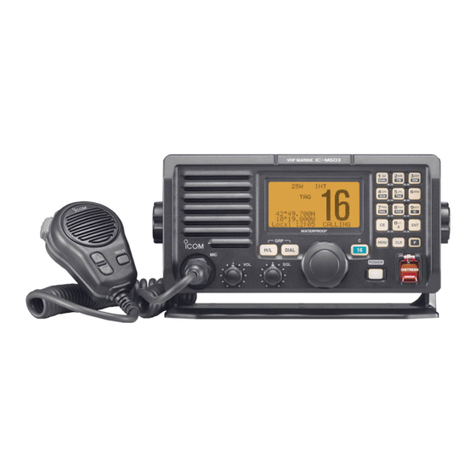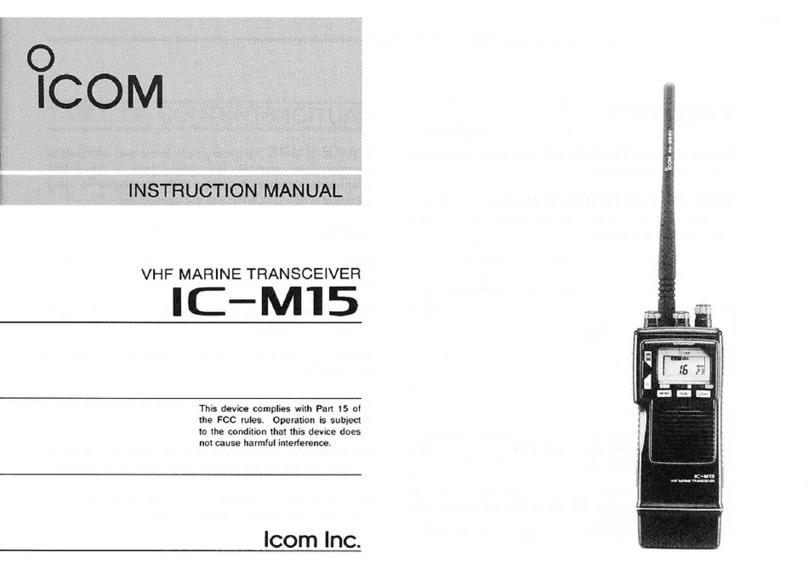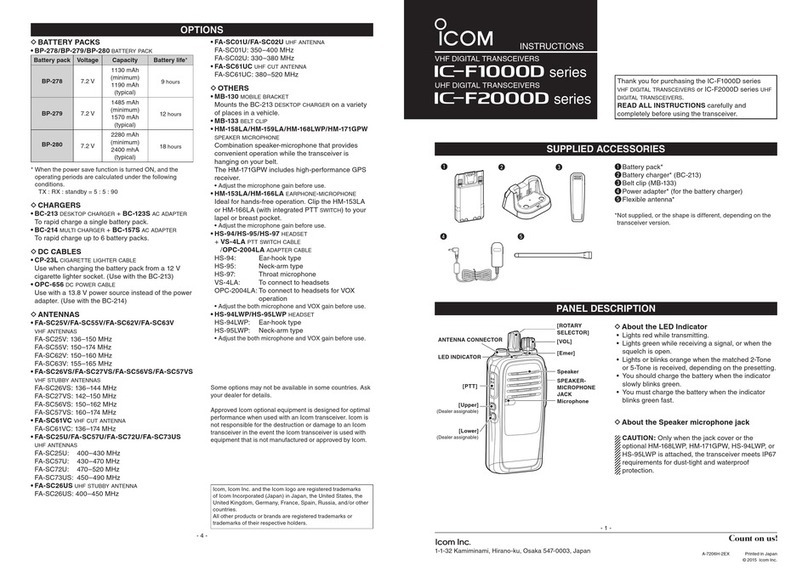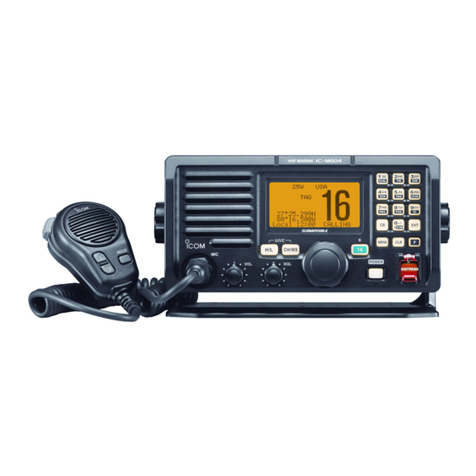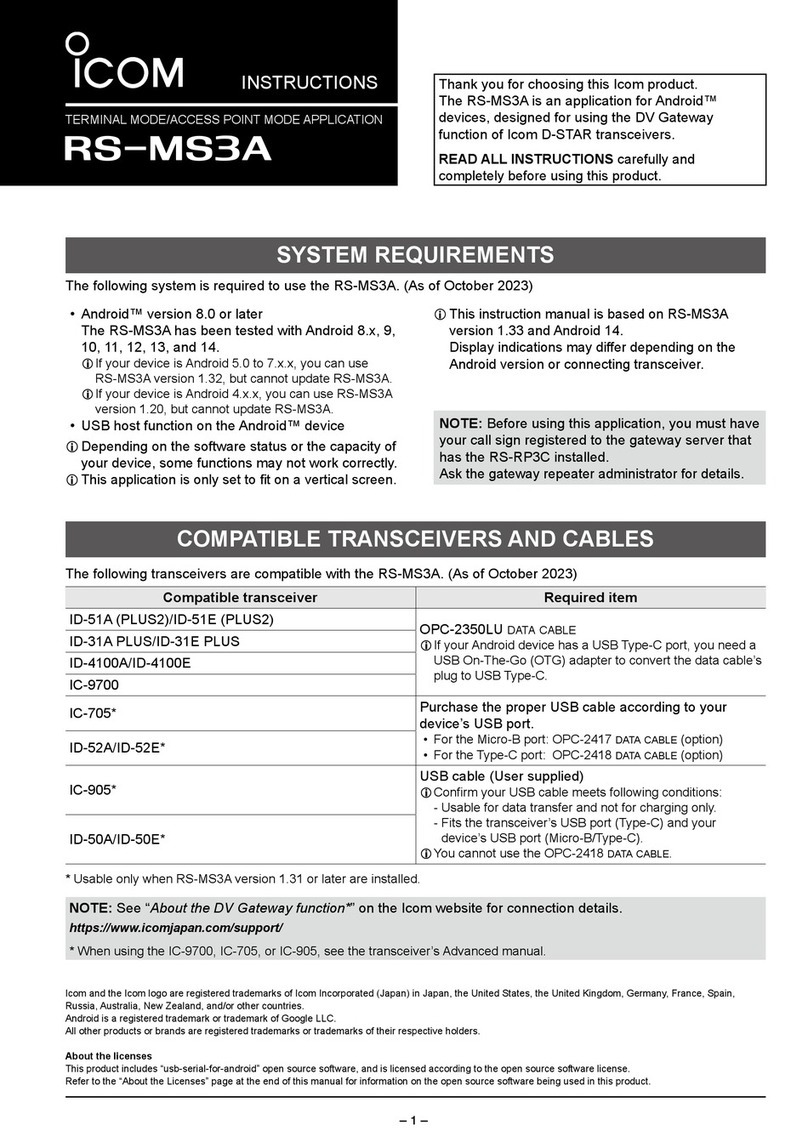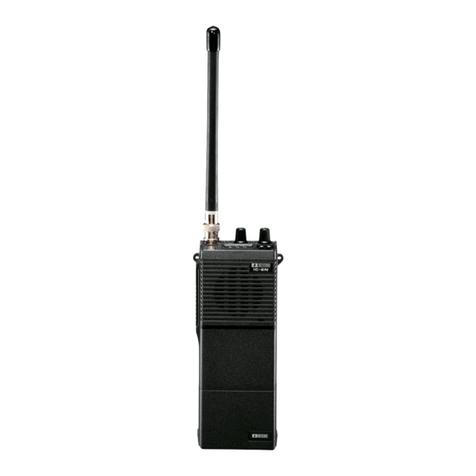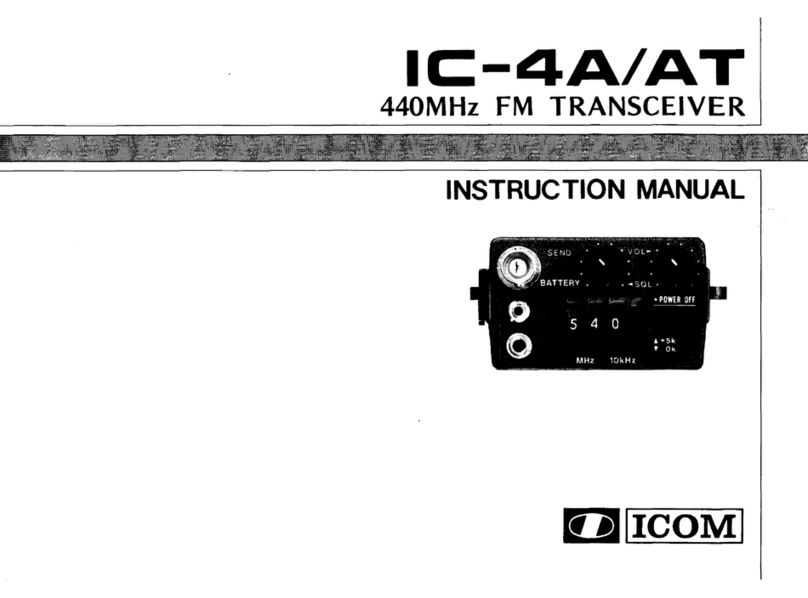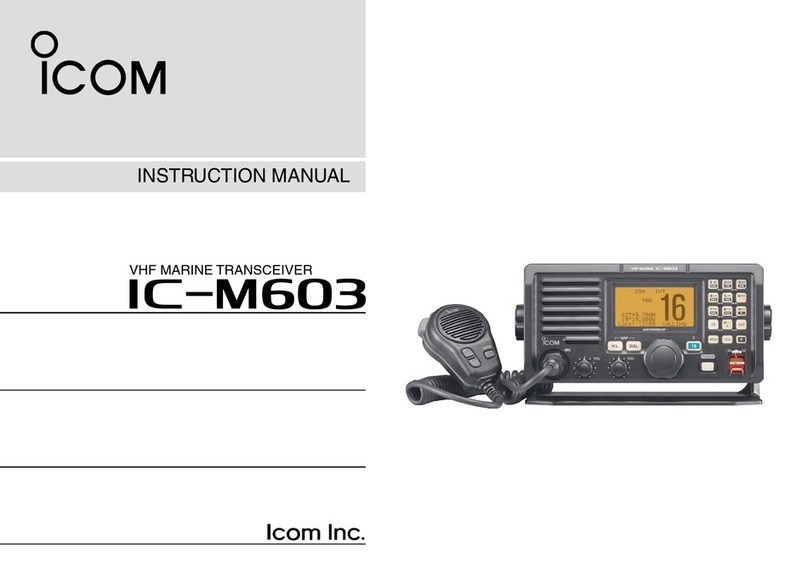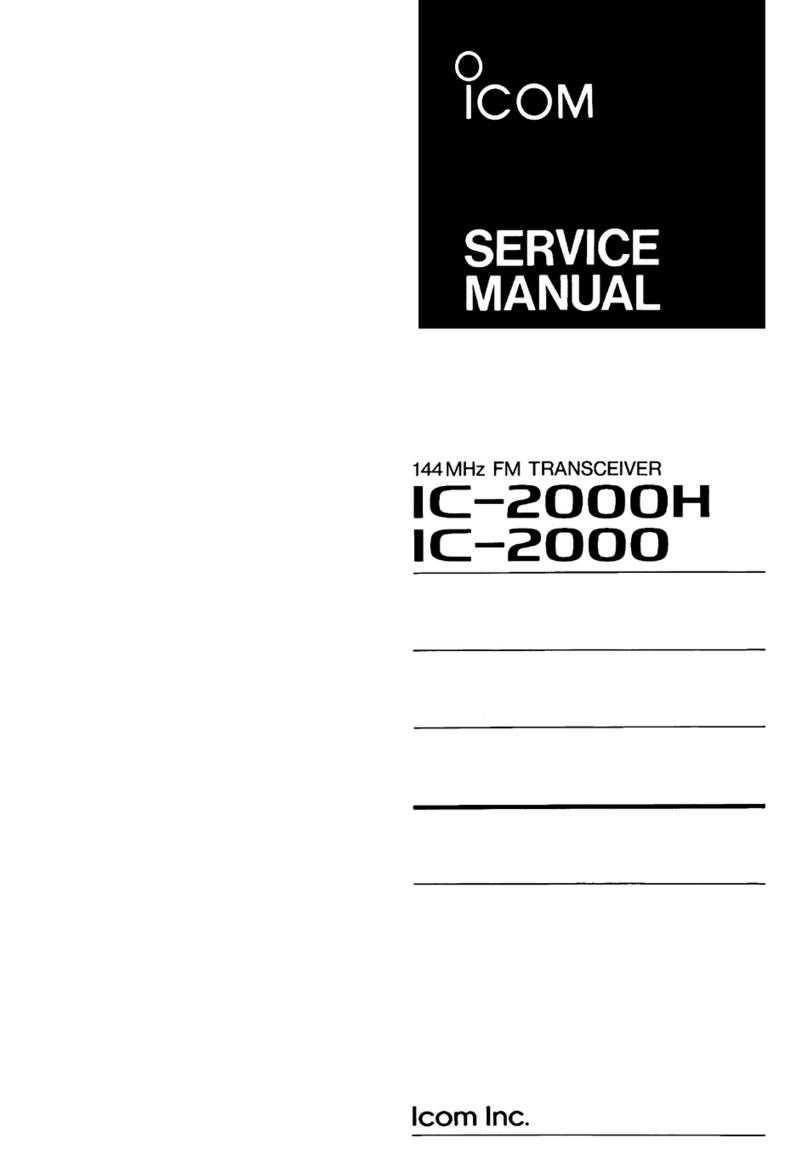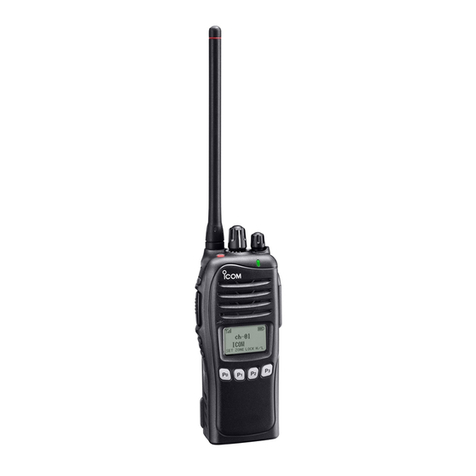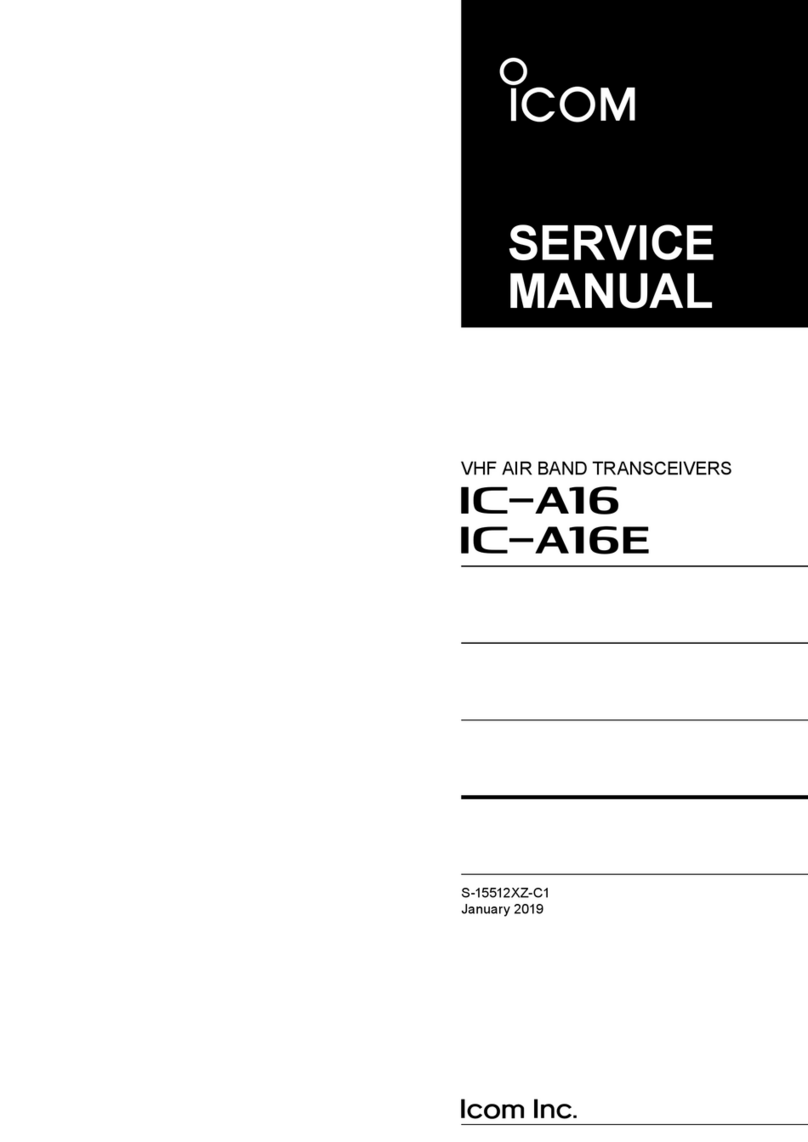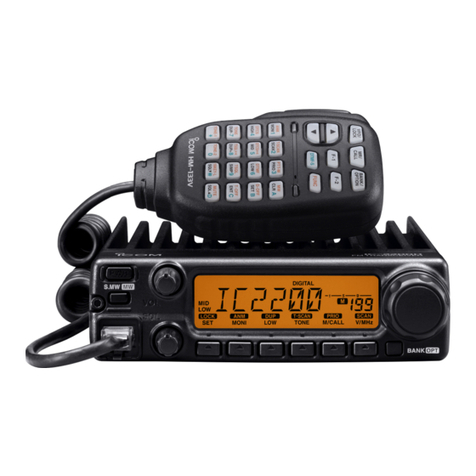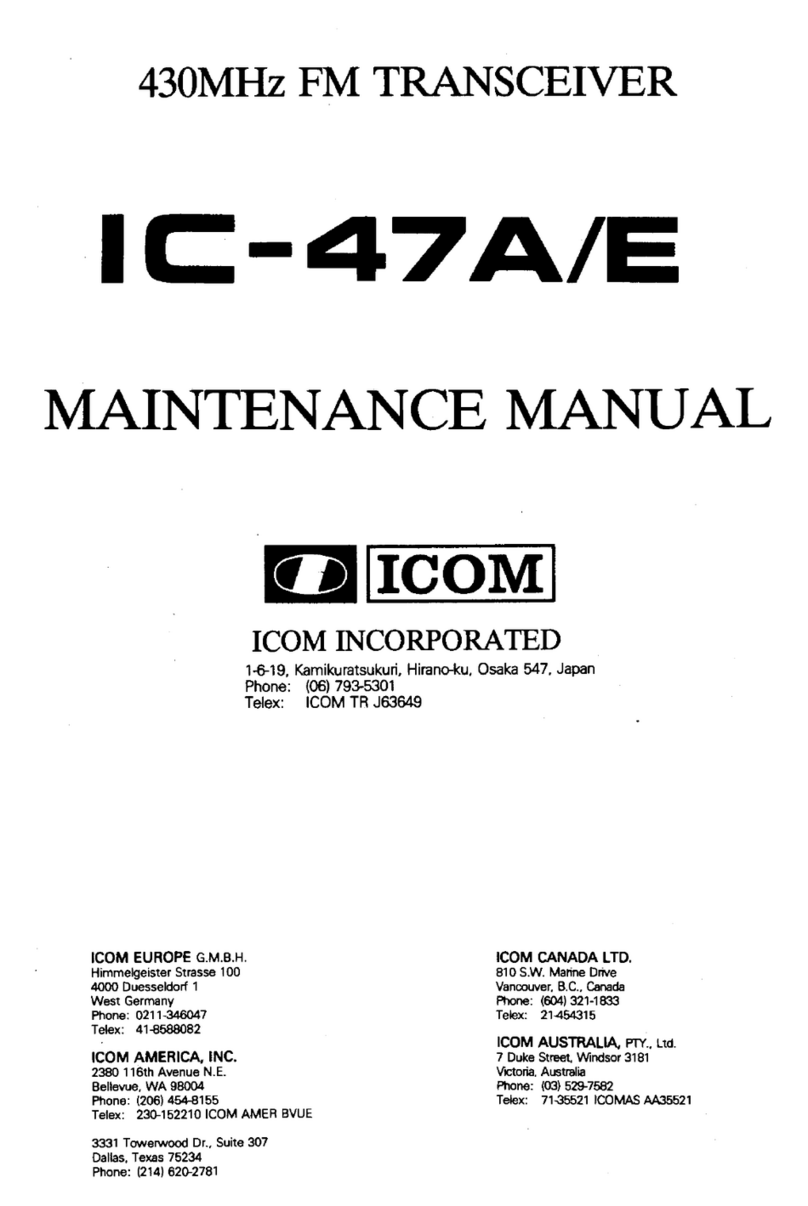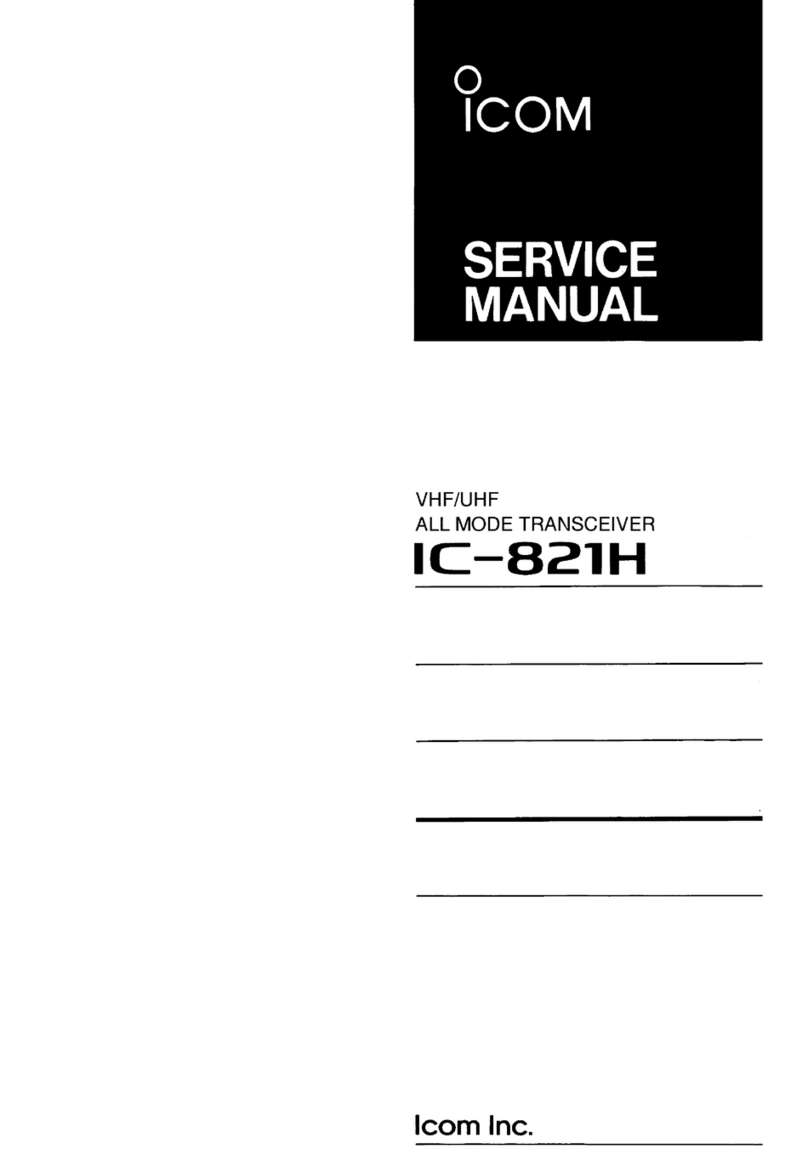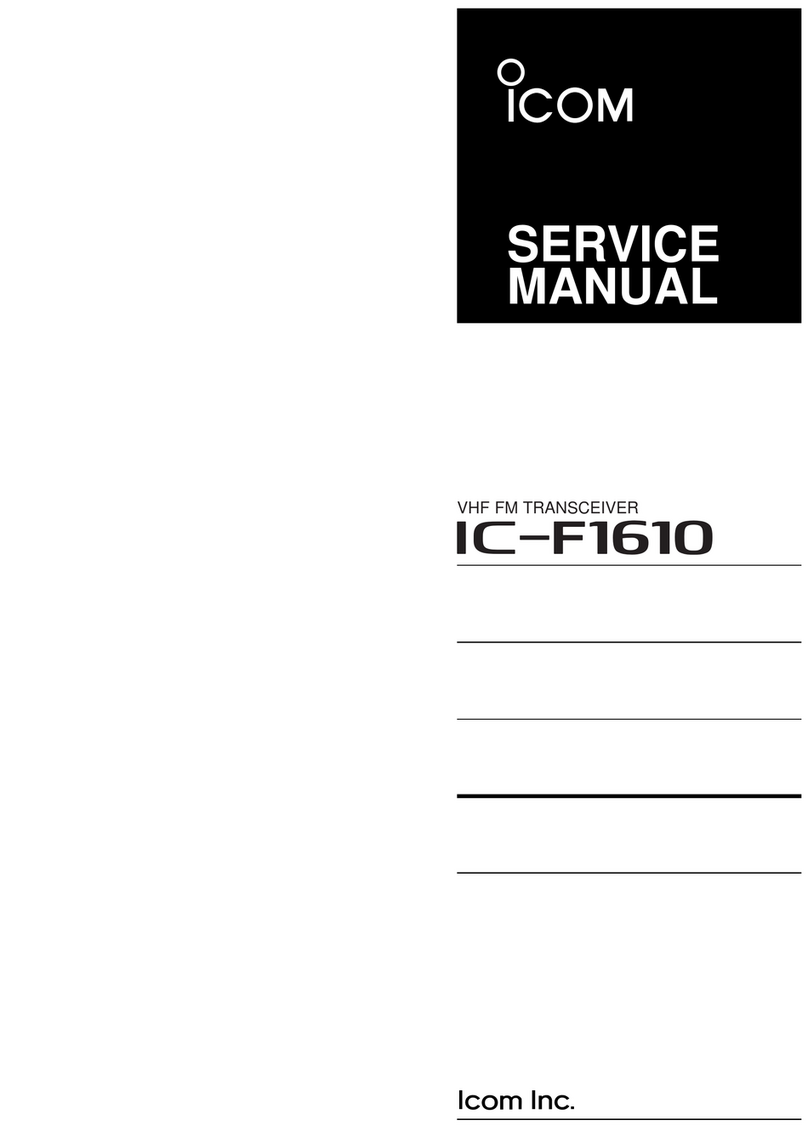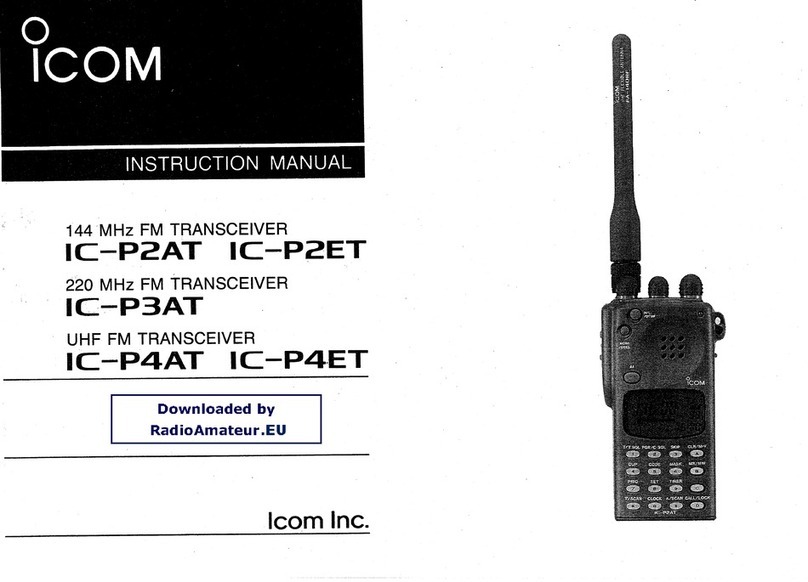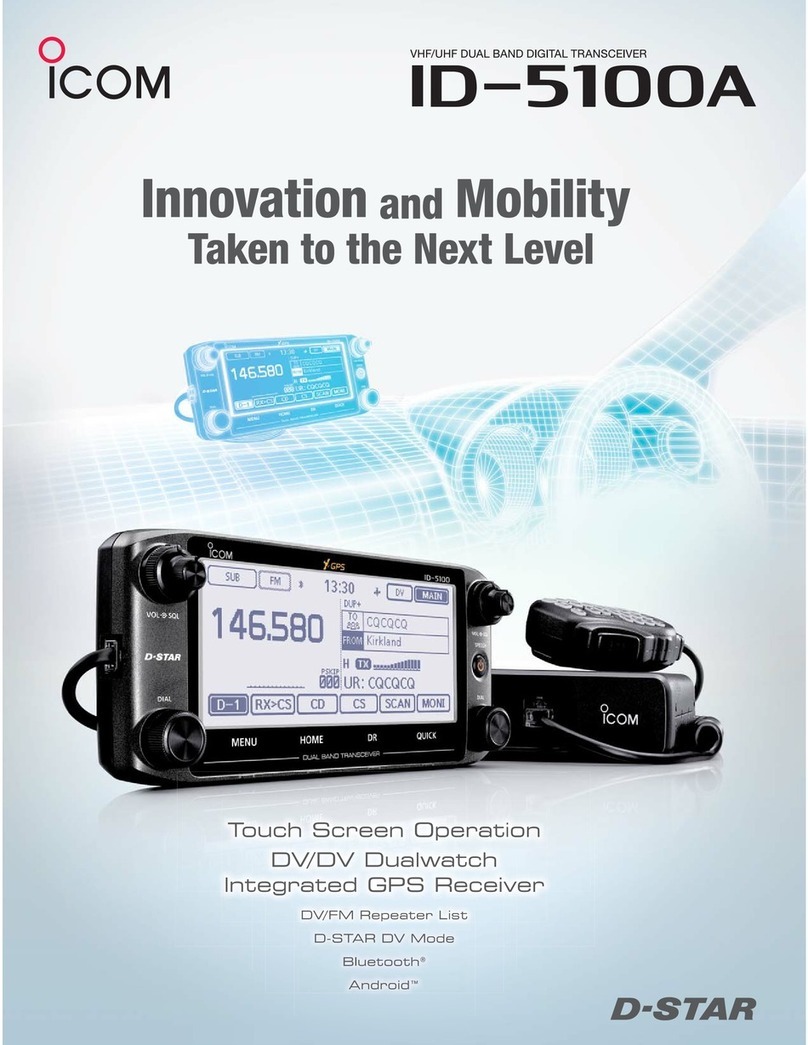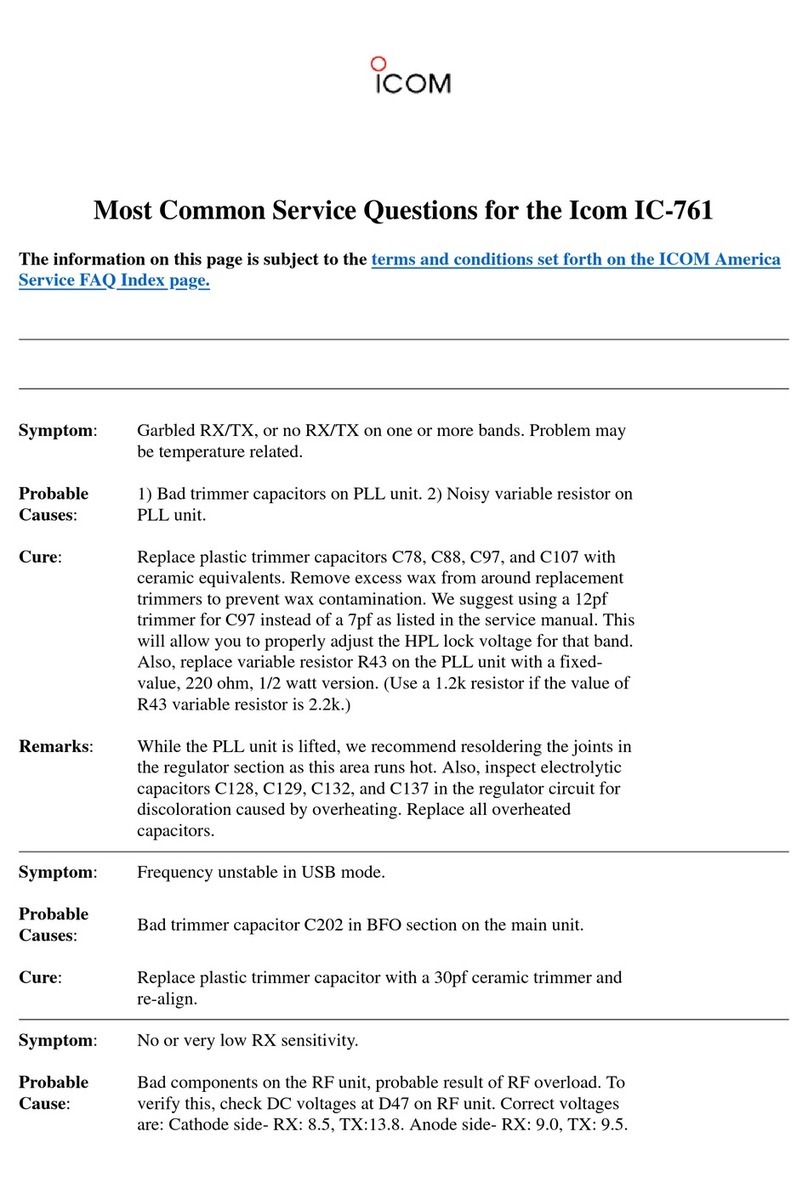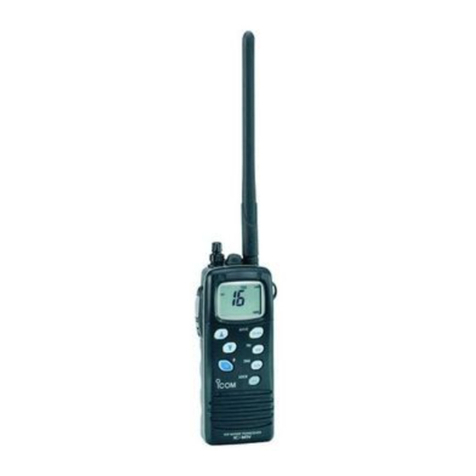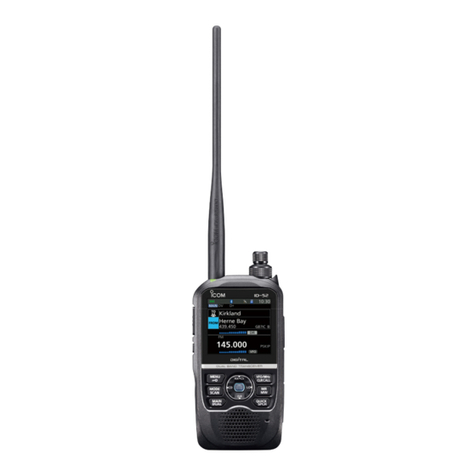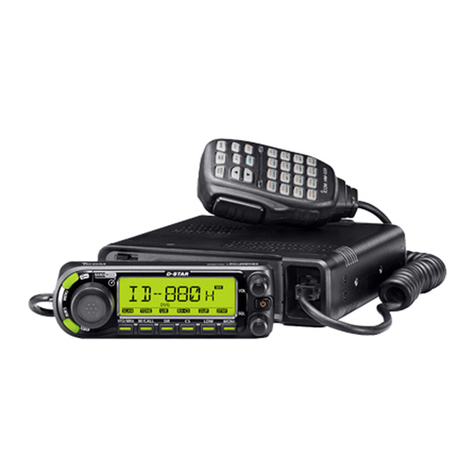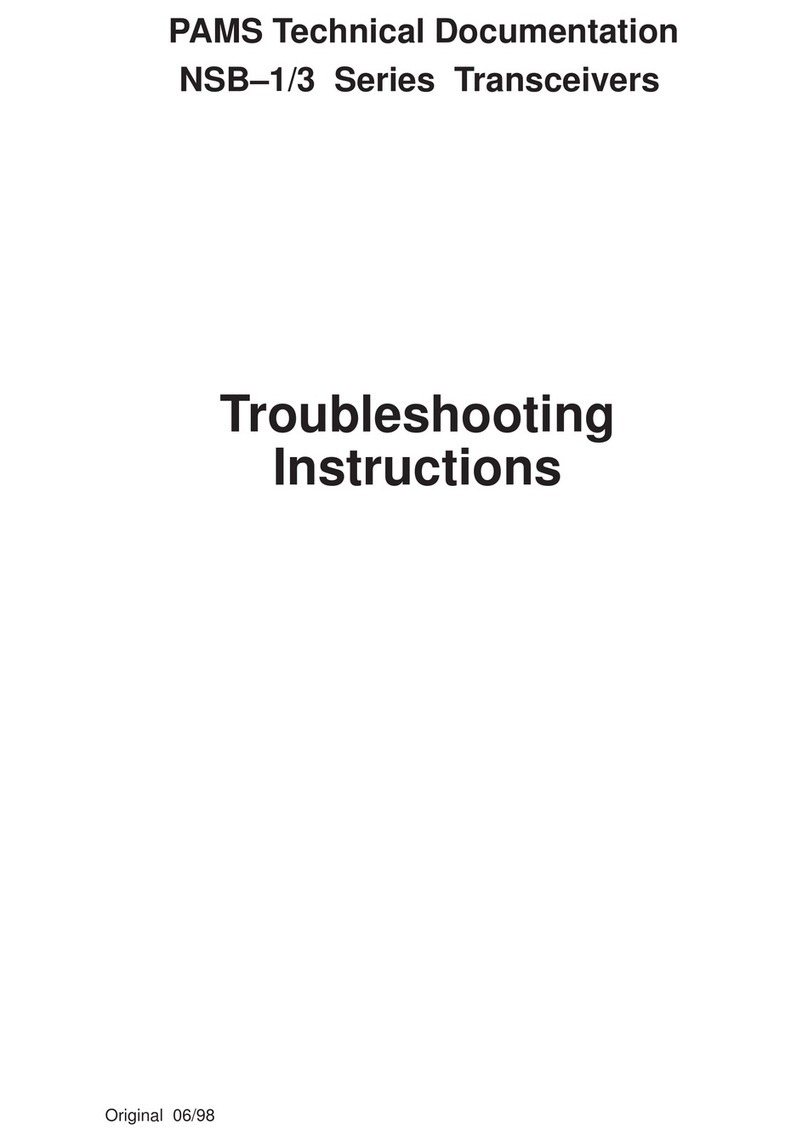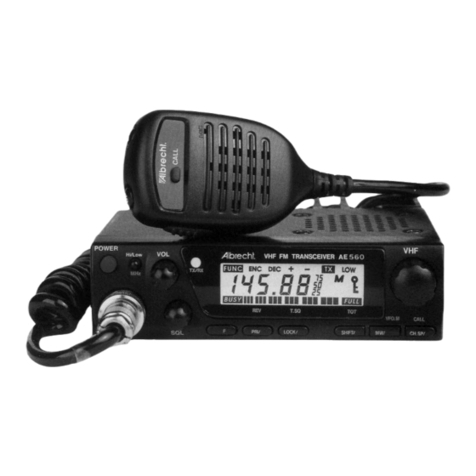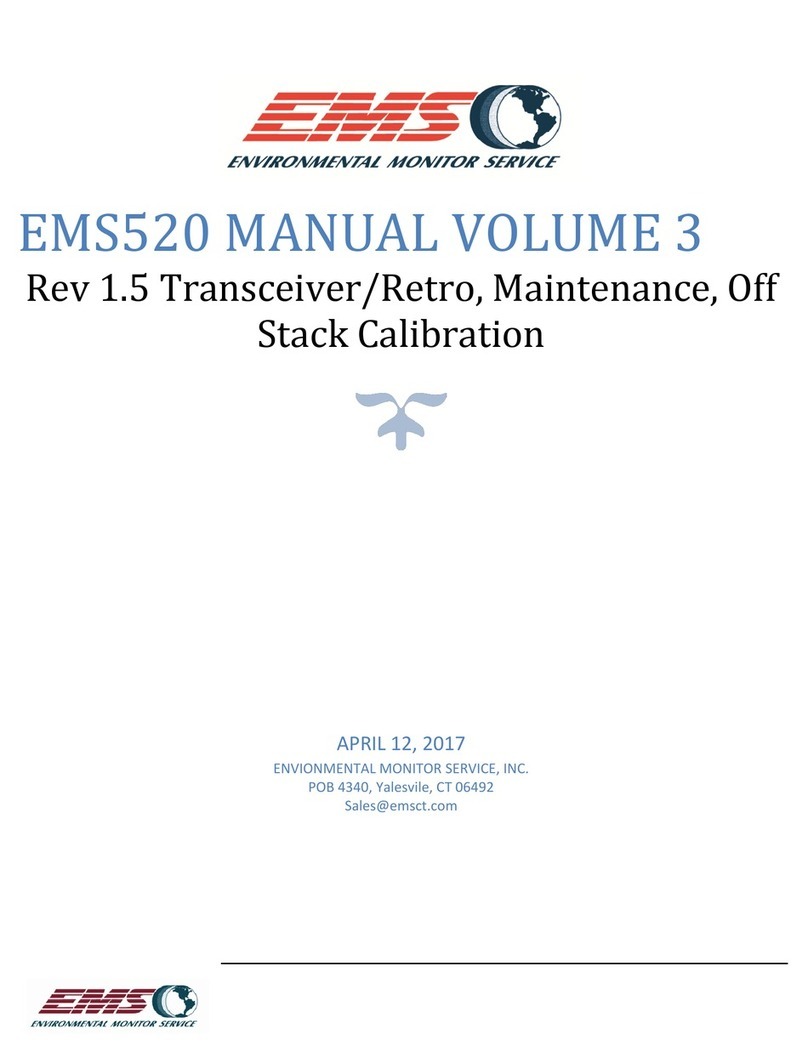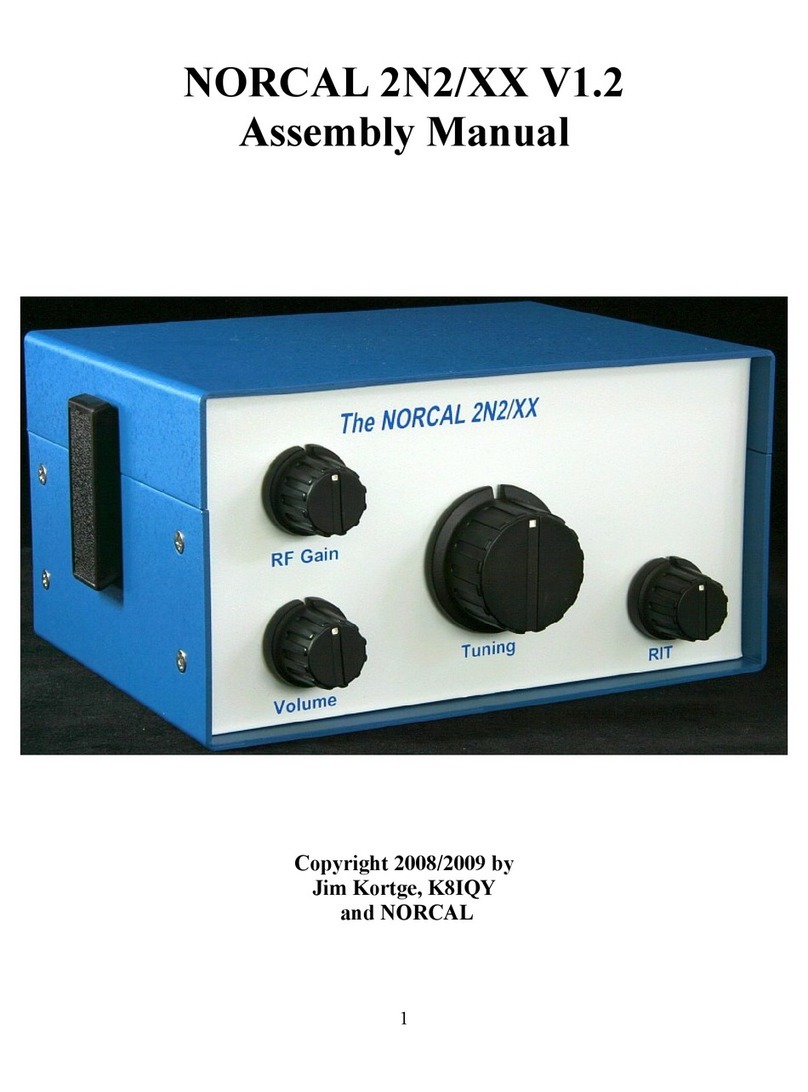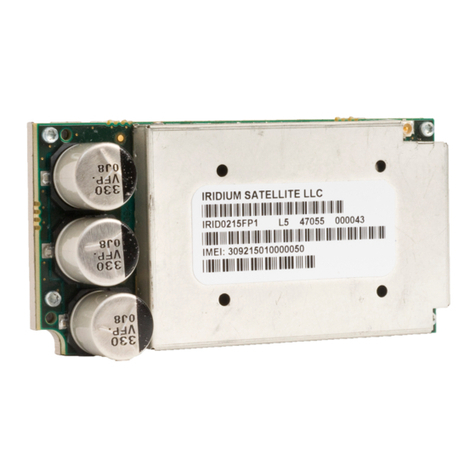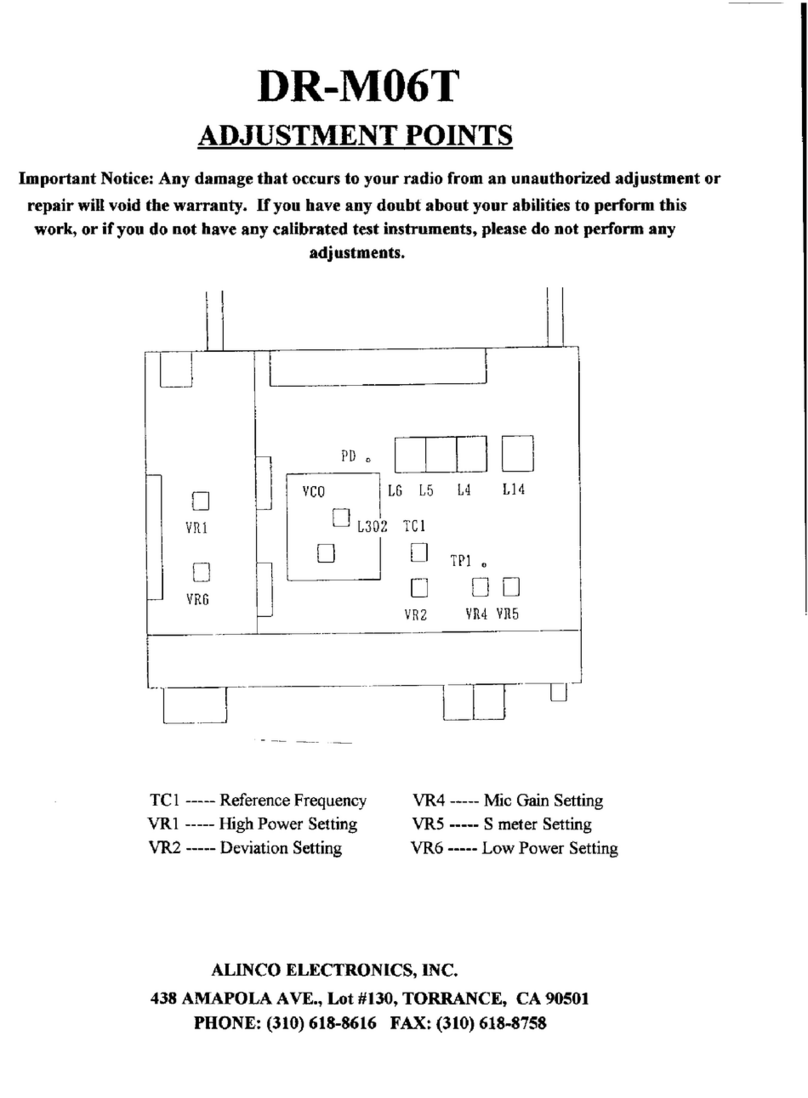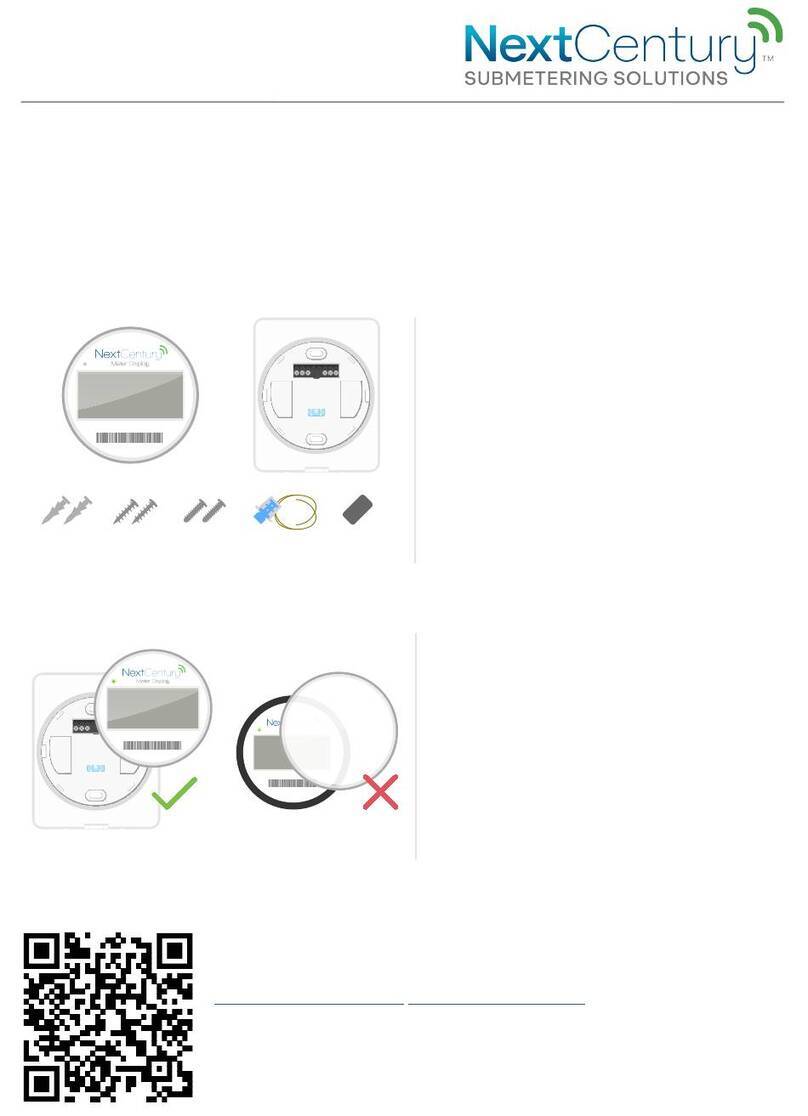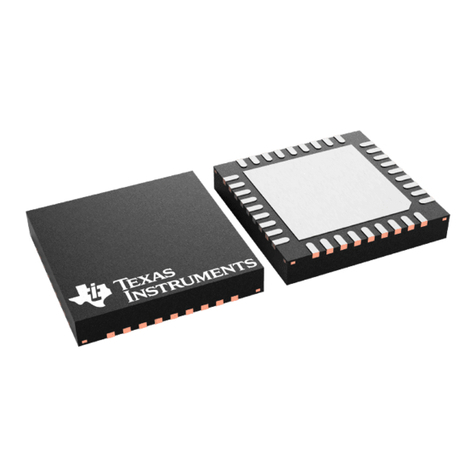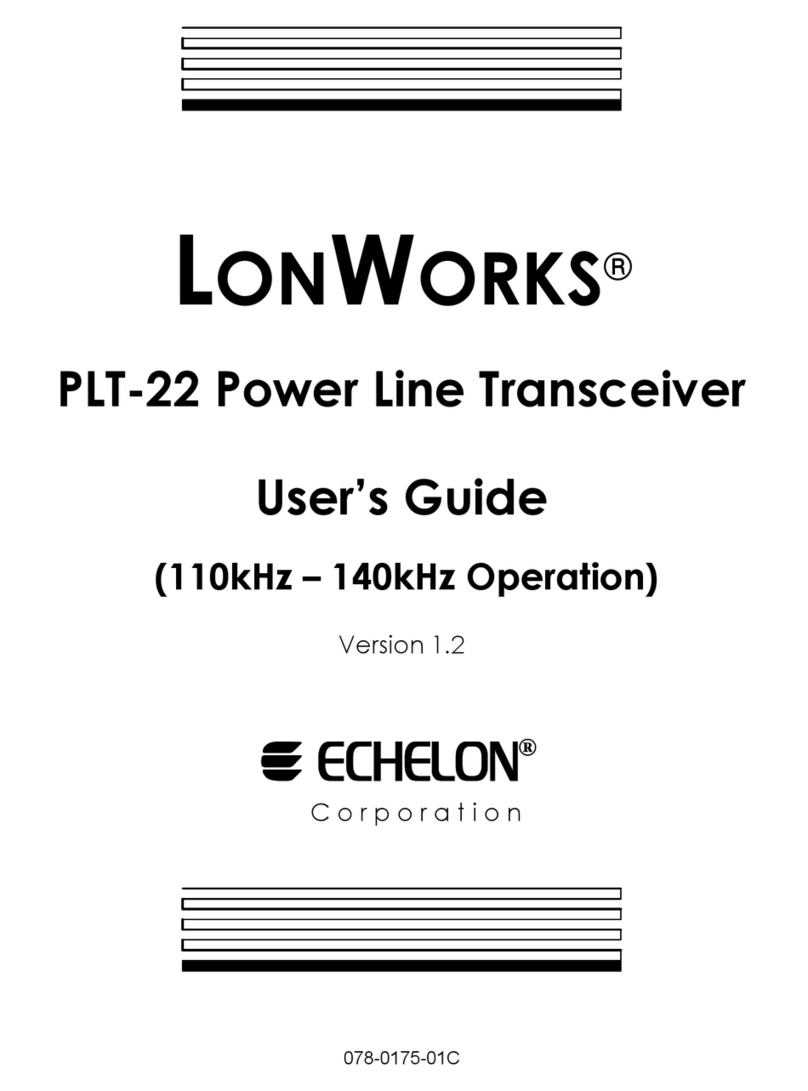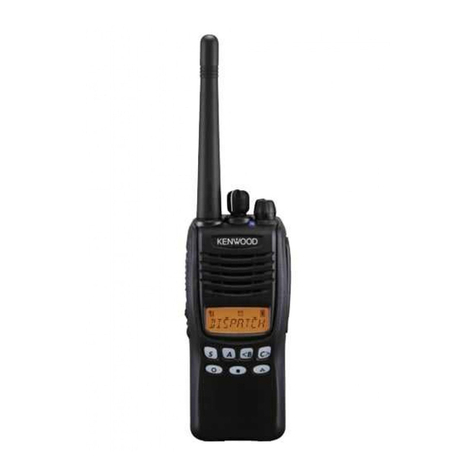Icom IC-F52D User manual

INSTRUCTIONS
A-7397H-1EX Printed in Japan
© 2017 Icom Inc.
1-1-32 Kamiminami, Hirano-ku, Osaka 547-0003, Japan
VHF/UHF DIGITAL TRANSCEIVERS
- 1 -
Thank you for choosing this Icom product.
READ ALL INSTRUCTIONS carefully and completely
before using this product.
This instruction sheet includes some functions that are
usable only when they are preset by your dealer. The
transceiver may have other functions and operations that
are not described in this instruction sheet. Ask your dealer
for preset function details.
IMPORTANT
Battery pack Belt clip Connector cover
(with a screw)
SUPPLIED ACCESSORIES
DAbout the Status indicator
• Lights white, then blinks red, yellow, and green when
turning ON the transceiver.
• Lights red while transmitting.
• Lights green while receiving a signal, or when the squelch
is open.
DAbout the Multi-connector
Connects to an optional speaker microphone or headset.
CAUTION:
DO NOT use the transceiver without the
connector cover
or the optional microphone attached.
The transceiver meets IP67 requirements for dust-tight and
waterproof protection only when the connector cover or the
optional microphone is attached.
DAbout the Software key functions
NOTE: Your dealers can assign the Software key
functions to the keys.
PANEL DESCRIPTION
DBATTERY PACKS
•BP-290 li-ion battery pack
Voltage: 7.2 V
Capacity: 1910 mAh (minimum), 2010 mAh (typical)
Battery life: Approximately 13 hours
•BP-291 battery case
Battery case for AA alkaline batteries.
DCHARGERS
•BC-226 desktop charger + BC-228 ac adapter
For rapidly charging battery packs.
Charging time: Approximately 2.7 hours
LA power adapter may be supplied, depending on the charger’s
version.
•BC-214 multi-charger
+ BC-157S ac adapter, OPC-656 dc power cable
For rapidly charging of up to 6 battery packs simultaneously.
Charging time: Approximately 2.8 hours
LThe AD-132N charger adapter may be needed, depending
on the charger's version.
LThe BC-157S ac adapter or OPC-656 dc power cable must
be purchased separately.
•BC-219N desktop charger + BC-123S ac adapter
For rapidly charging of battery packs.
Charging time: Approximately 2.5 hours for the BP-290
LA power adapter may be supplied, depending on the charger’s
version.
•BC-225 intelligent desktop charger + BC-123S ac
adapter + RS-BC225 reader software
For rapidly charging battery packs.
You can check the charging status using the RS-BC225.
Charging time: Approximately 2.5 hours for the BP-290
LA power adapter may be supplied, depending on the charger’s
version.
LAn USB (Micro-B) cable is required to connect the BC-225 and
a PC with the RS-BC225 installed.
DDC CABLES
•CP-23L cigarette lighter cable
Used when charging battery packs through a 12 V
cigarette lighter socket. For use with the BC-219N.
•OPC-515L, OPC-656 dc power cables
Used when charging battery packs using a 13.8 V DC
power source instead of the power adapter.
OPC-515L: For the BC-219N
OPC-656: For the BC-214
DANTENNAS
•FA-SC26VS, FA-SC27VS, FA-SC56VS, FA-SC57VS
FA-SC26US, FA-SC73US stubby antennas
Shorter VHF or UHF antennas.
FA-SC26VS: 136 ~ 144 MHz FA-SC27VS: 142 ~ 150 MHz
FA-SC56VS: 150 ~ 162 MHz FA-SC57VS: 160 ~ 174 MHz
FA-SC26US: 400 ~ 450 MHz FA-SC73US: 450 ~ 490 MHz
•FA-SC25V, FA-SC28V, FA-SC29V,
FA-SC01U, FA-SC25U, FA-SC57U, FA-SC72U flexible
antennas
VHF or UHF antennas.
FA-SC25V: 136 ~ 150 MHz FA-SC28V: 148 ~ 162 MHz
FA-SC29V: 160 ~ 174 MHz FA-SC01U: 350 ~ 400 MHz
FA-SC25U: 400 ~ 430 MHz FA-SC57U: 430 ~ 470 MHz
FA-SC72U: 470 ~ 520 MHz
• FA-SC61VC, FA-SC61UC cut antennas
• FA-SC62V, FA-SC63V high gain antennas
DBELT CLIPS and BELT HANGERS
• MB-136, MBB-3 belt clip
• MB-96F, MB-96FL, MB-96N belt hangers
DOTHERS
•HM-222 speaker microphone
With an Emergency key.
The HM-222 meets IP68 requirements for waterproof
protection.
•HM-233GP gps speaker microphone
The microphone with high-performance GPS receiver.
•HM-163MC tiepin type microphone
+ EH-15B earphone, SP-26 tube earphone, SP-28 ear
hook type earphone
•SP-32 tube type earphone adapter
For use with EH-15B.
• SP-27 tube earphone, SP-29 ear hook type earphone,
SP-40 earphone + AD-135 earphone adapter
AD-135: Used To connect an earphone to the transceiver’s
multi-connector.
• AD-118 acc adapter
To connect an accessory. See the AD-118 instruction
sheet for details on recommended accessories.
CAUTION: The AD-118 does not have waterproof
protection. When it is connected, NEVER expose the
adaptor and the transceiver to rain, snow or any liquids.
• LC-187, LC-188* carrying case
*Remove the LC-188 from the transceiver before charging.
•VS-5MC*ptt switch cable
+ HS-94, HS-95, HS-97 headset
VS-5MC: Used to connect a headset to a transceiver.
HS-94: Ear-hook type
HS-95: Neck-arm type
HS-97: Throat microphone
* Non-waterproof.
•VS-3 Bluetooth®headset
The Bluetooth headset with a [PTT] switch.
•About the third party Bluetooth headsets:
Icom has checked the PTT operation with some 3M Peltor
headsets such as the WS Headset XP, WS ProTac XP and
WS Alert XP. (Compatibility not guaranteed.)
OPTIONS
Some options may not be available in some countries.
Ask your dealer for details.
Icom, Icom Inc. and the Icom logo are registered trademarks of Icom Incor-
porated (Japan) in Japan, the United States, the United Kingdom, Germa-
ny, France, Spain, Russia, Australia, New Zealand, and/or other countries.
The Bluetooth word mark and logos are registered trademarks owned by
the Bluetooth SIG, Inc. and any use of such marks by Icom Inc. is under
license. Other trademarks and trade names are those of their respective
owners.
All other products or brands are registered trademarks or trademarks of
their respective holders.
- 4 -
Iç-F52D
Iç-F62D
[Rotary Encoder]
Antenna
Connector
[Emer]*
[PTT]
[Back]*
[OK]*
[F1]*
[F2]*
Speaker
[P1 (Down)]*
[P2 (Up)]*
[VOL]
Status
indicator
Micro-
phone
Multi-
connector
*Dealer assignable
NOTE:
• Some accessories are not supplied, or the shape is
different, depending on the transceiver version.
• Conrmbothbatteryslidinglocksarelockedinplace,
when attaching the battery to the transceiver. Both sliding
locks make a ‘click’ sound when locked.

- 2 - - 3 -
FUNCTION DISPLAY
DIcon Area
Indicators
qSIGNAL STRENGTH INDICATOR
Displays the relative receive signal strength level.
w BATTERY INDICATOR
Displayed or blinks to indicate the battery status.
Indication
Battery
status Full Mid Charging
required
Battery
exhausted
blinks when the battery is exhausted.
Icons
The following icons are displayed in the Icon Area.
SHIFT ICON
Displayed when the Shift function is ON.
LA user can use a Software key’s secondary function in the Shift
mode. Ask your dealer for details.
POWER ICON
Displays the output power level.
• “L1” is displayed when the output power is set to Low.
• “L2” is displayed when the output power is set to Mid.
• “H” is displayed when the output power is set to High.
AUDIBLE ICON
Displayed when the channel is in the ‘audible’ (unmute)
mode.
MESSAGE ICON
• Blinks after messages (Message or Status Message) have
been received.
• Stops blinking when the screen is changed, or any key is
pushed, but is displayed if unread messages are still in the
Message memory.
• Disappears when all messages in the Message memory
have been read.
BELL ICON
Displayed when a matching signal is received, depending
on the presetting.
SCAN ICON
•Displayed when a scan is paused.
• Blinks while scanning.
SCAN TARGET CHANNEL ICON
Displayed when the channel is selected as a scan target channel.
NOTE: The screen is an example.
The displayed position of each icon may differ, depending
on the function being used.
Icon Area
Text Area
Key Display
Area
SCRAMBLER/ENCRYPTION ICON
In the Analog mode:
•Displayed when the Voice Scrambler function is ON.
In the Digital mode:
• Displayed when the Encryption function is ON.
• Blinks when decoding an encrypted signal.
GPS ICON *
• Displayed when valid position data is received.
• Blinks when searching for satellites or calculating position
data.
*HM-233GP is required to use the GPS function.
RECORD ICON
• Displayed when the Record function is ON.
• Blinks while recording audio.
TALK AROUND ICON
Displayed when the Talk Around function is ON.
PHONE ICON
•Displayed when the transceiver is connected to a
telephone network on the selected channel.
• Blinks while receiving a phone call.
SITE LOCK ICON
Displayed when the Site Lock function is ON.
LONE WORKER ICON
Displayed when the Lone Worker function is ON.
MOTION SENSOR ICON
Displayed when the Motion Sensor function is ON.
NOISE CANCEL ICON
Displayed when the Noise Cancel function is ON.
SURVEILLANCE ICON
Displayed when the Surveillance function is ON.
VIBRATION ICON
Displayed when the Vibration function is ON.
VOX ICON *
Displayed when the VOX function is ON.
*VS-5MC, VS-3, or other Bluetooth headset is required to use the
VOX function.
Bluetooth®ICON
• “ ” is displayed when Bluetooth is activated.
• “ ” is displayed when a Bluetooth device is connected.
DText Area
Displays the selected Zone number, Channel number, and
Channel name, if set.
DKey Display Area
Displays the names of the function assigned to [P1] and [P2].
LAsk your dealer about the assigned Software key functions.
DTurning ON the transceiver
NOTE:Beforeusingthetransceiverforthersttime,the
battery pack must be fully charged for optimum life and
operation. See the BATTERY CHARGING section of this
sheet.
Rotate [VOL] to turn ON the transceiver.
DReceiving and Transmitting
Receiving:
1. Select a channel.
LRotate [Selector] or push [Up] or [Down], depending on the
presetting.
2. When receiving a call, rotate [VOL] to adjust the audio
output level to a comfortable listening level.
Transmitting:
CAUTION: Attach an antenna before transmitting.
Transmitting without an antenna may damage the
transceiver.
1. Wait until the channel is clear to avoid interference.
2. While holding down [PTT], speak at your normal voice
level.
3. Release [PTT] to receive.
IMPORTANT:
To maximize the readability of your signal:
1.Afterpushing[PTT],pausebrieflybeforeyoustart
speaking.
2. Hold the microphone 5 to 10 cm (2 to 4 inches) from
your mouth, then speak at your normal voice level.
BASIC OPERATION
BATTERY CHARGING
DRapid charging with the BC-219N
DRapid charging with the BC-214
You can rapidly charge up to 6 battery packs with the
optional BC-214.
Charging time:
Approximately 2.8 hours
Additionally needed items (purchase separately):
• The BC-157S ac adapter or the OPC-656 dc power cable
• The AD-132N charger adapter (may be supplied with the
charger, depending on the charger version)
CAUTION: NEVER reverse the polarity when connecting
the OPC-656 to a power source. This will ruin the battery
charger.
Red line: +,Black line: _
Battery pack
+ Transceiver
OPC-656
Connect to a
DC power supply:
12 to 16 V, at least 7 A
Red line: +
Black line: _
BC-214
BC-157S
Battery pack
Turn OFF
To an AC outlet
You can rapidly charge the Li-ion battery pack with the
BC-219N.
Charging time:
Approximately 2.5 hours
Additionally needed item (purchase separately):
• A power adapter (may be supplied with the charger,
depending on the charger version) or the OPC-515L/CP-23L dc
power cables.
CAUTION: NEVER reverse the polarity when connecting
the OPC-515L to a power source. This will ruin the battery
charger.
White line: +,Black line: _
NOTE:
• Before detaching or attaching a battery pack, BE SURE to turn OFF the transceiver by rotating [VOL] fully counter clockwise, until it makes a
“click” sound. Otherwise, a transceiver malfunction could occur.
Individual-3
Call High/Low
The OPC-515L
(For a 13.8 V DC
power source) or the
CP-23L (for a 12 V
cigarette lighter
socket) can be used
instead of the power
adapter.
Battery Pack
Power
Adapter*
Battery Pack
+ Transceiver
*
A different type, or no power adapter is
supplied, depending on the charger version.
Turn OFF
To an AC outlet
q w

PRECAUTIONS
A-7397H-2EX Printed in Japan
© 2017 Icom Inc.
1-1-32 Kamiminami, Hirano-ku, Osaka 547-0003, Japan
- 4 -
Thank you for choosing this Icom product.
READ ALL PRECAUTIONS carefully and completely
before using this product.
- 1 -
The AMBE+2™ voice coding Technology embodied in this
product is protected by intellectual property rights including
patent rights, copyrights and trade secrets of Digital Voice
Systems, Inc. This voice coding Technology is licensed
solely for use within this Communications Equipment.
The user of this Technology is explicitly prohibited from
attempting to extract, remove, decompile, reverse engineer,
or disassemble the Object Code, or in any other way
convert the Object Code into a human-readable form. U.S.
Patent Nos.
#5,870,405, #5,826,222, #5,754,974, #5,701,390,
#5,715,365, #5,649,050, #5,630,011, #5,581,656,
#5,517,511, #5,491,772, #5,247,579, #5,226,084 and
#5,195,166.
VOICE CODING TECHNOLOGY
CLEAN THE TRANSCEIVER THOROUGHLY WITH
FRESH WATER IN A BOWL after exposure to saltwater,
and dry it before operating. Otherwise, the transceiver's
keys, switches and controllers may become unusable, due
to salt crystallization, and/or the charging terminals of the
battery pack may rust.
NOTE: If the transceiver’s waterproof protection appears
defective, carefully clean it with a soft, wet (fresh water)
cloth, then, dry it before operating.
The transceiver may lose its waterproof protection if the
case, jack cap, or connector cover is cracked or broken, or
the transceiver has been dropped.
FCC INFORMATION
RECOMMENDATION
This equipment has been tested and found to comply with
the limits for a Class A digital device, pursuant to part 15
of the FCC Rules. These limits are designed to provide
reasonable protection against harmful interference when
the equipment is operated in a commercial environment.
This equipment generates, uses, and can radiate radio
frequency energy and, if not installed and used in
accordance with the instruction manual, may cause harmful
interference to radio communications. Operation of this
equipment in a residential area islikely to cause harmful
interference in which case the user will be required to
correct the interference at his own expense.
WORD DEFINITION
RDANGER! Personal death, serious injury or an
explosion may occur.
RWARNING! Personal injury, fi re hazard or electric
shock may occur.
CAUTION Equipment damage may occur.
NOTE Recommended for optimum use. No risk of
personal injury, fi re or electric shock.
R
DANGER! NEVER short the terminals of the battery pack.
Shorting may occur if the terminals touch metal objects such
as a key, so be careful when placing the battery packs (or the
transceiver) in bags, and so on. Carry them so that shorting
cannot occur with metal objects. Shorting may damage not
only the battery pack, but also the transceiver.
RDANGER! NEVER use or charge Icom battery packs
with non-Icom transceivers or non-Icom chargers. Only
Icom battery packs are tested and approved for use with
Icom transceivers or charged with Icom chargers. Using
third-party or counterfeit battery packs or chargers may
cause smoke, fi re, or cause the battery to burst.
RDANGER! NEVER operate the transceiver near
unshielded electrical blasting caps or in an explosive
atmosphere.
RWARNING! NEVER operate the transceiver with a
headset or other audio accessories at high volume levels.
The continuous high volume operation may cause a ringing
in your ears. If you experience the ringing, reduce the
volume level or discontinue use.
RWARNING! NEVER operate the transceiver while driving
a vehicle. Safe driving requires your full attention— anything
less could result in an accident.
CAUTION: DO NOT modify the transceiver. The
specifi cations may change and then the transceiver may not
comply with the requirements of required regulations. The
transceiver warranty does not cover any problems caused
by unauthorized modifi cation.
CAUTION: DO NOT carry the transceiver by holding the
antenna.
CAUTION: DO NOT operate unless the fl exible antenna,
battery pack are securely attached to the transceiver.
Confi rm that the antenna and battery pack are dry before
attaching. Exposing the inside of the transceiver to dust or
water can cause serious damage to the transceiver.
DO NOT place or leave the transceiver in direct sunlight or
in places with temperatures below –30°C (–22°F) or above
+60°C (+140°F). The basic operations of the transceiver
are guaranteed within the specifi ed operating temperature
range. However, the Liquid Crystal Display may not operate
correctly, or show an indication in the case of long hours of
operation, or after being placed in extremely cold areas.
CAUTION: DO NOT use harsh solvents such as benzine or
alcohol when cleaning. This could damage the equipment
surfaces. If the surface becomes dusty or dirty, wipe it clean
with a soft, dry cloth.
CAUTION: DO NOT operate the transceiver if it becomes
hot after continuously transmitting for long periods of time.
This may damage the transceiver.
BE CAREFUL! The transceiver meets IP67 requirements
for dust-tight and waterproof protection. However, once the
transceiver has been dropped, dust-tight and waterproof
protection cannot be guaranteed because of possible
damage to the transceiver’s case or the waterproof seal.
Even when the transceiver power is OFF, a slight current
still fl ows in the circuits. Remove the battery pack from the
transceiver when not using it for a long time. Otherwise, the
installed battery pack will become exhausted, and will need
to be recharged or replaced.
MAKE SURE to turn OFF the transceiver power before
connecting the supplied or optional equipment.
EXPLICIT DEFINITIONS
DISPOSAL
PRECAUTIONS
VHF/UHF DIGITAL TRANSCEIVERS
Icom, Icom Inc. and the Icom logo are registered trademarks
of Icom Incorporated (Japan) in Japan, the United States, the
United Kingdom, Germany, France, Spain, Russia, Australia, New
Zealand, and/or other countries.
AMBE+2 is a trademark and property of Digital Voice Systems Inc.
All other products or brands are registered trademarks or
trademarks of their respective holders.
The crossed-out wheeled-bin symbol on your
product, literature, or packaging reminds you
that in the European Union, all electrical and
electronic products, batteries, and
accumulators (rechargeable batteries) must be
taken to designated collection locations at the
end of their working life. Do not dispose of these products
as unsorted municipal waste. Dispose of them according to
the laws in your area.
ISO 3166-1
Country Codes Country Codes
1
2
3
4
5
6
7
8
9
10
11
12
13
14
15
16
17
Austria
Belgium
Bulgaria
Croatia
Czech Republic
Cyprus
Denmark
Estonia
Finland
France
Germany
Greece
Hungary
Iceland
Ireland
Italy
Latvia
AT
BE
BG
HR
CZ
CY
DK
EE
FI
FR
DE
GR
HU
IS
IE
IT
LV
18
19
20
21
22
23
24
25
26
27
28
29
30
31
32
33
Liechtenstein
Lithuania
Luxembourg
Malta
Netherlands
Norway
Poland
Portugal
Romania
Slovakia
Slovenia
Spain
Sweden
Switzerland
Turkey
United Kingdom
LI
LT
LU
MT
NL
NO
PL
PT
RO
SK
SI
ES
SE
CH
TR
GB
< Intended Country of Use >
AT
FI
IT
PL
GB
RO
BE
FR
LV
PT
IS
TR
CY
DE
LT
SK
LI
HR
CZ
GR
LU
SI
NO
DK
HU
MT
ES
CH
EE
IE
NL
SE
BG
COUNTRY CODE LIST
CAUTION: Changes or modifi cations to this transceiver,
not expressly approved by Icom Inc., could void
your authority to operate this transceiver under FCC
regulations.
This device complies with Part 15 of the FCC Rules.
Operation is subject to the condition that this device does
not cause harmful interference.
Iç-F52D
Iç-F62D
ABOUT CE
Versions of the IC-F52D and IC-F62D
which have the “CE” symbol on the product,
comply with the essential requirements of
the Radio Equipment Directive, 2014/53/
EU, and the restriction of the use of certain hazardous
substances in electrical and electronic equipment Directive,
2011/65/EU.
About declaration of conformity
Hereby, Icom Inc. declares that the radio equipment type
IC-F52D and IC-F62D is in compliance with Directive
2014/53/EU. The full text of the EU declaration of
conformity is available at the following internet address:
http://www.icom.co.jp/world/support/

- 2 - - 3 -
DBattery caution
Misuse of Li-ion batteries may result in the following
hazards: smoke, fi re, or the battery may rupture. Misuse
can also cause damage to the battery or degradation of
battery performance.
RDANGER! NEVER solder the battery terminals, or
NEVER modify the battery pack. This may cause heat
generation, and the battery may burst, emit smoke or catch
fi re.
RDANGER! NEVER place or leave battery packs in areas
with temperatures above +60°C (+140°F). High temperature
buildup in the battery cells, such as could occur near fi res or
stoves, inside a sun-heated vehicle, or in direct sunlight for
long periods of time may cause the battery cells to rupture
or catch fi re. Excessive temperatures may also degrade the
battery pack’s performance or shorten the battery cell's life.
RDANGER! NEVER strike or otherwise impact the battery
pack. Do not use the battery pack if it has been severely
impacted or dropped, or if the pack has been subjected to
heavy pressure. Battery pack damage may not be visible
on the outside of the case. Even if the surface of the battery
does not show cracks or any other damage, the cells inside
the battery may rupture or catch fi re.
RDANGER! NEVER expose the battery pack to rain,
snow, seawater, or any other liquids. Do not charge or use a
wet pack. If the pack gets wet, be sure to wipe it dry before
using.
RDANGER! NEVER place or leave battery packs near fi re.
Fire or heat may cause them to rupture or explode. Dispose
of used battery packs in accordance with local regulations.
RDANGER! NEVER let fl uid from inside the battery get in
your eyes. This can cause blindness. Rinse your eyes with
clean water, without rubbing them, and immediately go to a
doctor.
RWARNING! NEVER put the battery pack in a microwave
oven, high-pressure container, or in an induction heating
cooker. This could cause a fi re, overheating, or cause the
battery cells to rupture.
RWARNING! NEVER use the battery pack if it emits an
abnormal odor, heats up, or is discolored or deformed. If
any of these conditions occur, contact your Icom dealer or
distributor.
RWARNING! NEVER Iet fl uid from inside the battery cells
come in contact with your body. If it does, immediately wash
with clean water.
CAUTION: DO NOT use the battery pack out of the
specifi ed temperature range for the transceiver (–30°C ~
+60°C (–22°F ~ +140°F)) and the battery itself (–20°C ~
+60°C (–4°F ~ +140°F)). Using the battery out of its
specifi ed temperature range will reduce its performance and
battery cell's life. Please note that the specifi ed temperature
range of the battery may exceed that of the transceiver. In
such cases, the transceiver may not work properly because
it is out of its operating temperature range.
CAUTION: Shorter battery life could occur if the battery is
left fully charged, completely discharged, or in an excessive
temperature environment (above +50°C (+122°F)) for
an extended period of time. If the battery pack must be
left unused for a long time, it must be detached from the
transceiver after discharging. You may use the battery pack
until the remaining capacity is about half, then keep it safely
in a cool and dry place at the following temperature range:
–20°C ~ +50°C (–4°F ~ +122°F) (within a month)
–20°C ~ +40°C (–4°F ~ +104°F) (within three months)
–20°C ~ +20°C (–4°F ~ +68°F) (within a year)
BE SURE to replace the battery pack with a new one
approximately fi ve years after manufacturing, even if it still
holds a charge. The inside battery material will become
weak after a period of time, even with little use. The
estimated number of times you can charge the battery is
between 300 and 500. Even when the battery appears to
be fully charged, the operating time of the transceiver may
become short when:
• Approximately fi ve years have passed since the battery was
manufactured.
• The battery has been repeatedly charged.
DCharging caution
RDANGER! NEVER charge the battery pack in areas with
extremely high temperatures, such as near fi res or stoves,
inside a sun-heated vehicle, or in direct sunlight. In such
environments, the safety/protection circuit in the battery will
activate, causing the battery to stop charging.
RWARNING! NEVER charge the transceiver during a
lightning storm. It may result in an electric shock, cause a
fi re or damage the transceiver. Always disconnect the power
adapter before a storm.
RWARNING! NEVER charge or leave the battery in the
battery charger beyond the specifi ed time for charging. If
the battery is not completely charged by the specifi ed time,
stop charging and remove the battery from the battery
charger. Continuing to charge the battery beyond the
specifi ed time limit may cause a fi re, overheating, or the
battery may rupture.
RWARNING! NEVER insert the transceiver (battery
attached to the transceiver) into the charger if it is wet or
soiled. This could corrode the battery charger terminals or
damage the charger. The charger is not waterproof.
CAUTION: NEVER charge the battery outside of the
specifi ed temperature range: BC-214 and BC-219N (+16˚C
~ +40˚C (+60.8˚F ~ +104˚F)). Otherwise, the charging time
will be longer, but the battery will not reach a full charge.
While charging, at a point after the temperature goes out of
the specifi ed range, the charging will automatically stop.
PRECAUTIONS (continued)
SAFETY TRAINING INFORMATION
WARNING
Your Icom radio generates RF electromagnetic energy while transmitting. This radio is designed for
and classifi ed as for “Occupational Use Only.” This means it must be used only during the course of
employment by individuals aware of the hazards, and the ways to minimize such hazards. This radio is
NOT intended for use by the “General Population” in an uncontrolled environment. This radio has been
tested and complies with the FCC and IC RF exposure limits for “Occupational Use Only”. In addition,
your Icom radio complies with the following Standards and Guidelines with regard to RF energy and
electromagnetic energy levels and evaluation of such levels for exposure to humans:
• FCC KDB Publication 447498 D03, Evaluating Compliance with FCC Guidelines for Human Exposure to Radio Frequency
Electromagnetic Fields.
• American National Standards Institute (C95.1-1992), IEEE Standard for Safety Levels with Respect to Human Exposure to
Radio Frequency Electromagnetic Fields, 3 kHz to 300 GHz.
• American National Standards Institute (C95.3-1992), IEEE Recommended Practice for the Measurement of Potentially
Hazardous Electromagnetic Fields– RF and Microwave.
• The antennas, batteries, belt clips, speaker-microphone, and other accessories that are listed in “OPTIONS” on the
INSTRUCTIONS sheet, are authorized for use with this product. Use of accessories other than those specifi ed may result in
RF exposure levels exceeding the FCC and IC requirements for wireless RF exposure.
• Health Canada Safety Code 6 - Limits of Human Exposure to Electromagnetic Energy in the Frequency Range from 3 kHz to
300 GHz.
CAUTION
To ensure that your expose to RF electromagnetic energy is within the FCC and IC allowable limits for
occupational use, always adhere to the following guidelines:
DO NOT operate the radio without a proper antenna attached, as this may damage the radio and may
also cause you to exceed FCC and IC RF exposure limits. A proper antenna is the antenna supplied with
this radio by the manufacturer or an antenna specifi cally authorized by the manufacturer for use with this
radio.
DO NOT transmit for more than 50% of the total radio use time (“50% duty cycle”). Transmitting more than 50% of the time can
cause FCC and IC RF exposure compliance requirements to be exceeded. The radio is transmitting when the LED indicator
lights red. You can cause the radio to transmit by pushing the “PTT” switch.
ALWAYS keep the antenna at least 2.5 cm (1 inch) away from the body when transmitting, and only use the Icom belt-clips
listed in “OPTIONS” of the INSTRUCTIONS sheet when attaching the radio to your belt, or other place, to ensure FCC and IC
RF exposure compliance requirements are not exceeded.
The information listed above provides the user with the information needed to make him or her aware of RF exposure, and
what to do to assure that this radio operates within the FCC and IC RF exposure limits of this radio.
Electromagnetic Interference/Compatibility
During transmissions, your Icom radio generates RF energy that can possibly cause interference with other devices or
systems. To avoid such interference, turn off the radio in areas where signs are posted to do so. DO NOT operate the
transmitter in areas that are sensitive to electromagnetic radiation such as hospitals, aircraft, and blasting sites.
Occupational/Controlled Use
The radio transmitter is used in situations in which persons are exposed as a consequence of their employment, provided
those persons are fully aware of the potential for exposure and can exercise control over their exposure.
Icom is not responsible for the destruction, damage to, or
performance of any Icom or non-Icom equipment, if the
malfunction is because of:
• Force majeure, including, but not limited to, fi res,
earthquakes, storms, fl oods, lightning, other natural
disasters, disturbances, riots, war, or radioactive
contamination.
• The use of Icom transceivers with any equipment that is
not manufactured or approved by Icom.

RDANGER! NE JAMAIS connecter les bornes du pack
batterie en court-circuit.
RDANGER! NE JAMAIS utiliser la radio près d'amorces
électriques non blindées ni dans une atmosphère explosive.
non blindé détonateur électrique.
RDANGER! Utiliser et charger exclusivement les packs
EDWWHULHV,FRPVSpFL¿pVDYHFOHVSRUWDWLIV,FRPRXXQ
chargeurs Icom. Seuls les packs batterie Icom sont testés
et homologués pour une utilisation avec les radios Icom ou
être chargés avec les chargeurs Icom. L'utilisation de packs
EDWWHULHRXGHFKDUJHXUVWLHUVRXGHFRQWUHIDoRQSHXWrWUHj
ORULJLQHGHIXPpHVGLQFHQGLHRXIDLUHpFODWHUODEDWWHULH
RAVERTISSEMENT! NE JAMAIS utiliser l’appareil avec
un casque ou d’autres accessoires audio réglés sur un
niveau sonore élevé. Les spécialistes de l'audition mettent
HQJDUGHFRQWUHWRXWHXWLOLVDWLRQSURORQJpHjQLYHDXVRQRUH
élevé. Si vous entendez une sonnerie baissez le niveau
sonore ou interrompez l'utilisation.
RAVERTISSEMENT! NE JAMAIS utiliser la radio en
conduisant un véhicule. La sécurité de la conduite requiert
WRXWHO¶DWWHQWLRQGXFRQGXFWHXU²WRXWHGpIDLOODQFHSHXWrWUH
jO¶RULJLQHG¶XQDFFLGHQW
MISE EN GARDE: NE JAMAIS de nettoyer l’appareil
avec des produits chimiques telsque l’essence ou l’alcool
VXVFHSWLEOHVG¶HQGRPPDJHUODVXUIDFHGHODUDGLR
MISE EN GARDE: NE JAMAIS tenir l’émetteur-récepteur
par l’antenne pour le transport.
MISE EN GARDE:YpUL¿HUTXHODQWHQQHÀH[LEOHEDWWHULH
HWFDFKHGHODSULVHVRQWVROLGHPHQW¿[pVjODUDGLRHWTXH
ODQWHQQHHWODEDWWHULHVRQWVHFVDYDQWGH¿[DWLRQ6LYRXV
H[SRVH]jOLQWpULHXUGHODUDGLRjODSRXVVLqUHRXjOHDXOD
radio sera remarquablement endommagé.
ÉVITER
d’utiliser ou de laisser la radio en plein soleil ou a une
WHPSpUDWXUHDPELDQWHLQIpULHXUHD±&±)RXVXSpULHXUHD
&)/HVRSpUDWLRQVGHEDVHGHODUDGLRVRQWJDUDQWLV
GDQVODSODJHGHWHPSpUDWXUHGHIRQFWLRQQHPHQWVSpFL¿pH
&HSHQGDQWOpFUDQ/&'SHXWQHSDVIRQFWLRQQHUFRUUHFWHPHQW
DSUqVDYRLUpWpSODFpVGDQVGHV]RQHVH[WUrPHPHQWIURLGHVRX
XQHLF{QHDSSDUDvWORUVGXIRQFWLRQQHPHQWGHODUDGLRSHQGDQW
une longue période de temps.
NE PASPRGL¿HUODUDGLR/HVVSpFL¿FDWLRQVSHXYHQW
FKDQJHUHWSXLVQHSDVVHFRQIRUPHUDX[H[LJHQFHVGXQ
règlement correspondu. La garantie du radio ne couvre pas
OHVSUREOqPHVUpVXOWDQWGXQHPRGL¿FDWLRQQRQDXWRULVpH
ATTENTION! /DUDGLRFKDXIIHHQFDVG¶XWLOLVDWLRQFRQWLQXH
sur une longue durée.
ATTENTION! La radio répond IP67 exigences de protection
pWDQFKHjODSRXVVLqUHHWjOHDX0DLVORUVTXHODUDGLRHVW
WRPEpYHUVOHEDVpWDQFKHjODSRXVVLqUHHWjODSURWHFWLRQ
LPSHUPpDEOHjOHDXQHSHXYHQWSDVrWUHJDUDQWLVSDUFH
que le cas de la radio ou le joint d'étanchéité peuvent être
endommagés.
0rPHORUVTXHO¶pPHWWHXUUpFHSWHXUHVWPLVKRUVWHQVLRQ
XQFRXUDQWGHWUqVIDLEOHLQWHQVLWpFLUFXOHGDQVVHVFLUFXLWV
Retirez la batterie de la radio quand ne pas l'utiliser pendant
XQHORQJXHSpULRGH6LQRQODEDWWHULHVHUDGpFKDUJpHHW
devra être rechargée ou remplacée.
Assurez-vous de couper l'alimentation de la radio avant de
EUDQFKHUOpTXLSHPHQWIRXUQLRXHQRSWLRQ
35e&$87,216
$+(; 3ULQWHGLQ-DSDQ
,FRP,QF
.DPLPLQDPL+LUDQRNX2VDND-DSDQ
5$',269+)8+)',*,7$/
- 4 -
0HUFLG¶DYRLUFKRLVLXQSURGXLW,FRP
LIRE TOUTES LES PRÉCAUTIONS soigneuse-
ment et intégralement avant d’utiliser la radio.
- 1 -
TERME DÉFINITION
RDANGER! 5LVTXHGDFFLGHQWPRUWHOGHEOHVVXUHVFRUSRUHOOHVJUDYHVRXGH[SORVLRQ
RAVERTISSEMENT! 5LVTXHGHEOHVVXUHVFRUSRUHOOHVGLQFHQGLHRXGHFKRFpOHFWULTXH
MISE EN GARDE Risque de dégât matériel.
REMARQUE La non prise en compte peut entraîner des désagréments. Absence de risque de blessures corpo-
UHOOHVGLQFHQGLHRXGHFKRFpOHFWULTXH
DÉFINITIONS EXPLICITES
PRÉCAUTIONS
• POUR LES RAYONNEMENTS NON INTENTIONNELS
DE CLASSE A:
&HWpTXLSHPHQWDpWpWHVWpHWUHFRQQXFRQIRUPHDX[
OLPLWHV¿[pHVSRXUXQDSSDUHLOQXPpULTXHGHFODVVH$
FRQIRUPpPHQWDXSRLQWGHODUpJOHPHQWDWLRQ)&&
&HVOLPLWHVDVVXUHQWXQHSURWHFWLRQUDLVRQQDEOHFRQWUH
OHVLQWHUIpUHQFHVQXLVLEOHVORUVTXHOpTXLSHPHQWHVWXWLOLVp
dans un environnement commercial. &HWpTXLSHPHQW
JpQqUHXQHpQHUJLHGHUDGLRIUpTXHQFHXWLOLVHHWUD\RQQHU
HWVLOQHVWSDVLQVWDOOpHWXWLOLVpFRQIRUPpPHQWDXPDQXHO
GLQVWUXFWLRQSHXWFDXVHUGHVLQWHUIpUHQFHVQXLVLEOHV
DX[FRPPXQLFDWLRQVUDGLR/HIRQFWLRQQHPHQWGHFHW
équipement dans une zone résidentielle est susceptible de
FDXVHUGHVLQWHUIpUHQFHVQXLVLEOHVORUVTXHOXWLOLVDWHXUGRLW
FRUULJHUOHVLQWHUIpUHQFHVjVHVSURSUHVIUDLV
MISE EN GARDE:
7RXWFKDQJHPHQWRXPRGL¿FDWLRQQRQH[SUHVVpPHQWDS
SURXYpSDU,FRP,QFSHXWDQQXOHUODXWRULVDWLRQGHOXWLOL
VDWHXUjXWLOLVHUFHWDSSDUHLOFRQIRUPpPHQWjODUpJOHPHQ
WDWLRQ)&&
&HWDSSDUHLOUHVSHFWHOHVFRQGLWLRQVpWDEOLHVDXSDUDJUDSKH
GHVUqJOHVGHOD)&&6RQXWLOLVDWLRQHVWDVVXMHWWLHjOD
FRQGLWLRQGHQHSDVSURYRTXHUGHVLQWHUIpUHQFHVQXLVLEOHV
INFORMATION FCC
/HV\VWqPHGHFRGDJH$0%(XWLOLVpGDQVFHSURGXLW
HVWSURWpJpSDUOHVUqJOHPHQWVGHSURSULpWpLQWHOOHFWXHOOH
LQFOXDQWGHVGURLWVGHSURSULpWpGHVFRS\ULJKWVHWGHV
DFFRUGVGHFRQ¿GHQWLDOLWpVXUOHVV\VWqPHVGHQXPpULVDWLRQ
de la voix. La licence concernant la technologie de codage
de la voix est concédée seulement pour être utilisée avec
cet équipement de communication.
,OHVWIRUPHOOHPHQWLQWHUGLWjOXWLOLVDWHXUGHVVD\HUGH[WUDLUH
de décompiler ou de réaliser du "reverse engineering" ou
tout autre opération ayant pour but de convertir le code objet
VRXVXQHIRUPHOLVLEOH
HW
TECHNOLOGIE DE CODAGE DE LA VOIX
NETTOYEZ ENTIÈREMENT L'ÉMETTEUR-RÉCEPTEUR
AVEC DE L'EAU DOUCEHQFDVGH[SRVLWLRQjOHDXGH
PHUHWOHVpFKHUDYDQWGHOXWLOLVHU$XWUHPHQWOHVWRXFKHV
GHOpPHWWHXUUpFHSWHXUOHVFRPPXWDWHXUVHWOHVFRQWU{OHXUV
ULVTXHQWGHGHYHQLULQXWLOLVDEOHVjFDXVHGHODFULVWDOOLVDWLRQ
GXVHOHWRXOHVERUQHVGHUHFKDUJHGXEORFEDWWHULH
risquent de rouiller.
REMARQUE: Si la protection étanche de
OpPHWWHXUUpFHSWHXUVHPEOHGpIHFWXHXVHODQHWWR\HU
VRLJQHXVHPHQWDYHFXQWLVVXPRXHWKXPLGHGHDX
GRXFHSXLVODVpFKHUDYDQWGHOXWLOLVHU/pPHWWHXU
récepteur risque de perdre sa protection étanche si
OHERLWLHUOHFDSXFKRQGXMDFNRXOHFRXYHUFOHGX
FRQQHFWHXUHVWIrOpRXFDVVpRXHQFDVGHFKXWHGH
l'émetteur-récepteur.
RECOMMENDATION
,FRP,FRP,QFHWOHORJR,FRPVRQWGHVPDUTXHVGpSRVpHVGH
,FRP,QFRUSRUDWHG-DSRQDX-DSRQDX[eWDWV8QLVDX5R\DXPH
8QLHQ$OOHPDJQHHQ)UDQFHHQ(VSDJQHHQ5XVVLHHQ
$XVWUDOLHHQ1RXYHOOH=pODQGHHWRXGDQVGDXWUHVSD\V
$0%(HVWXQHPDUTXHGpSRVpHHWSURSULpWpGH'LJLWDO9RLFH
Systems Inc.
7RXVOHVDXWUHVSURGXLWVHWWRXWHVOHVDXWUHVPDUTXHVVRQWGHV
PDUTXHVGpSRVpHVRXQRQDSSDUWHQDQWjOHXUWLWXODLUHUHVSHFWLI
Icom n'est pas responsable de la destruction ou
GHVGRPPDJHVVXUOpPHWWHXUUpFHSWHXU,FRPVLOH
G\VIRQFWLRQQHPHQWHVWFDXVpSDU
)RUFHPDMHXUHVDQVWRXWHIRLVV\OLPLWHUOHVLQFHQGLHV
WUHPEOHPHQWVGHWHUUHWHPSrWHVLQRQGDWLRQV
ODIRXGUHRXDXWUHVFDWDVWURSKHVQDWXUHOOHV
SHUWXUEDWLRQVpPHXWHVJXHUUHRXFRQWDPLQDWLRQ
radioactive.
• L'utilisation de l'émetteur-récepteur Icom avec tout
pTXLSHPHQWQRQIDEULTXpRXDSSURXYpSDU,FRP
Iç-F52D
Iç-F62D

- 2 - - 3 -
DMise en garde concernant la batterie
Un mauvais usage des batteries au Lithium ion peut avoir les
FRQVpTXHQFHVVXLYDQWHVIXPpHLQFHQGLHRXH[SORVLRQGH
la batterie. Il peut également causer des dommages a une
DXWUHEDWWHULHRXGpJUDGHUOHVSHUIRUPDQFHVGHODEDWWHULH
RDANGER! NE JAMAIS souder les contacts de la
batterie NIPRGL¿HUVDFRPSRVLWLRQ&HFLSHXWSURYRTXHU
XQHVXUFKDXIIHGHODEDWWHULHTXLULVTXHDORUVGpFODWHUGH
IXPHURXGHSUHQGUHIHX
RDANGER! NE JAMAIS utiliser ni laisser le pack batterie
jXQHPSODFHPHQWRODWHPSpUDWXUHHVWVXSpULHXUHj
&)/DPRQWpHHQWHPSpUDWXUHGHODEDWWHULH
FRPPHFHODSHXWVXUYHQLUjSUR[LPLWpGHÀDPPHVRXGH
SRrOHVjOLQWpULHXUGXQYpKLFXOHH[SRVpDXVROHLORXHQ
SOHLQVROHLOSHXWGpWUXLUHRXHQÀDPPHUODEDWWHULH/HV
températures excessives peuvent également dégrader les
SHUIRUPDQFHVGHODEDWWHULHRXUpGXLUHOHXUORQJpYLWp
RDANGER! NE PAS marteler ni cogner la batterie d’une
TXHOFRQTXHIDoRQ1XWLOLVH]SDVODEDWWHULHVLHOOHDUHoX
GHVLPSDFWVRXDpWpMHWpHRXVLHOOHDVXELXQHIRUWH
pression. Les dommages subis par une batterie peuvent ne
SDVrWUHYLVLEOHVGHOH[WpULHXUGXERvWLHU0rPHVLODVXUIDFH
GHODEDWWHULHQHVHPEOHSDV¿VVXUpHRXHQGRPPDJpHOHV
FHOOXOHVjOLQWpULHXUGHODEDWWHULHSHXYHQWVHURPSUHRX
SUHQGUHIHX
RDANGER! NE PASH[SRVHUODEDWWHULHjODSOXLHOD
QHLJHO¶HDXGHPHURXWRXWDXWUHOLTXLGH1HSDVFKDUJHU
RXXWLOLVHUXQHEDWWHULHKXPLGH6LXQHEDWWHULHHVWKXPLGH
YHLOOH]jOHVVX\HUFRPSOqWHPHQWDYDQWGHOXWLOLVHU
RDANGER!7HQLUjOpFDUWEDWWHULHVDXIHX)HXRXOD
FKDOHXUSHXWSURYRTXHUXQHUXSWXUHRXGH[SORVHU'LVSRVHU
GHEDWWHULHVXWLOLVpHVFRQIRUPpPHQWjODUpJOHPHQWDWLRQ
locale.
RDANGER! Utiliser la batterie uniquement avec la radio
SRXUOHTXHOHOOHHVWVSpFL¿pH1HMDPDLVXWLOLVHUXQHEDWWHULH
avec tout autre équipement ou pour une autre destination
TXHFHOOHVSpFL¿pHGDQVOHSUpVHQWPDQXHOGXWLOLVDWLRQ
RDANGER!'DQVOHFDVRGXOLTXLGHSURYHQDQWGH
OLQWpULHXUGHODEDWWHULHHQWUHGDQVYRV\HX[YRXVULVTXH]
ODFpFLWp5LQFH]DERQGDPPHQWOHV\HX[jOHDXFRXUDQWH
VDQVOHVIURWWHUHWFRQVXOWH]LPPpGLDWHPHQWXQPpGHFLQ
RAVERTISSEMENT! NE JAMAIS mettre la batterie dans
XQIRXUjPLFURRQGHVXQUpFLSLHQWKDXWHSUHVVLRQRXGDQV
XQIRXUjLQGXFWLRQ&HFLSHXWSURYRTXHUXQLQFHQGLHXQH
VXUFKDXIIHRXGpWpULRUHUODEDWWHULH
RAVERTISSEMENT!&HVVH]LPPpGLDWHPHQWGXWLOLVHU
ODEDWWHULHVLHOOHGpJDJHXQHRGHXUDQRUPDOHVLHOOH
VXUFKDXIIHHVWGpFRORUpHRXGpIRUPpH6LOXQHGHFHV
VLWXDWLRQVVHSURGXLWFRQWDFWH]YRWUHUHYHQGHXURX
distributeur Icom.
RAVERTISSEMENT! /DYH]LPPpGLDWHPHQWjOHDX
courante toute partie du corps qui est entrée en contact
avec le liquide provenant de l'intérieur de la batterie.
MISE EN GARDE:7RXMRXUVXWLOLVHUODEDWWHULHGDQVODSODJH
GHWHPSpUDWXUHVSpFL¿pHFRPSULVHHQWUH±&HW&
±)j)HWGHODEDWWHULHHOOHPrPHGH±&j
&±)j)/¶XWLOLVDWLRQGHODEDWWHULHKRUVGHOD
SODJHGHWHPSpUDWXUHLQGLTXpHDSRXUHIIHWG¶HQDOWpUHUOHV
SHUIRUPDQFHVHWG¶HQUpGXLUHODGXUpHGHYLH
MISE EN GARDE: La longévité de la batterie peut être
pFRXUWpHVLHOOHHVWODLVVpHGHPDQLqUHSURORQJpHjSOHLQH
FKDUJHHQWLqUHPHQWGpFKDUJpHRXGDQVXQHQYLURQQHPHQW
jWHPSpUDWXUHH[FHVVLYHVXSpULHXUHj&)
Si la batterie ne doit pas être utilisée pendant une assez
ORQJXHSpULRGHHOOHGRLWrWUHHQOHYpHGHOD9+)XQHIRLV
GpFKDUJpH9RXVSRXYH]XWLOLVHUODEDWWHULHMXVTXjFHTXH
OHWpPRLQGHODEDWWHULHLQGLTXHTXHOOHHVWjODPRLWLpGHVD
FDSDFLWp3ODFH]ODHQVXLWHGDQVXQHQGURLWIUDLVHWVHFGDQV
ODSODJHGHWHPSpUDWXUHFLDSUqV
±&a&±)a) SpULRGHLQIpULHXUHjXQPRLV
±&a&±)a) SpULRGHLQIpULHXUHjWURLVPRLV
±&a&±)a) SpULRGHLQIpULHXUHjXQHDQQpH
VEILLEZjUHPSODFHUODEDWWHULHSDUXQHQRXYHOOHDSUqV
FLQTDQVPrPHVLHOOHPDLQWLHQWODFKDUJH/HVPDWpULDX[
SUpVHQWVjOLQWpULHXUGHODEDWWHULHVHGpWpULRUHQWDSUqV
XQFHUWDLQWHPSVPrPHHQFDVGXWLOLVDWLRQUpGXLWH/H
QRPEUHGHIRLVRLOHVWSRVVLEOHGHFKDUJHUODEDWWHULHHVW
HVWLPpHQWUHHWIRLVHQIRQFWLRQGHOXWLOLVDWLRQ
0rPHORUVTXHODEDWWHULHLQGLTXHTXHOOHHVWFRPSOqWHPHQW
FKDUJpHOHWHPSVGXWLOLVDWLRQGXSRVWHSHXWrWUHUpGXLW
GDQVOHVFDVVXLYDQWV
•Sono passati approssimativamente cinque anni dalla data di
IDEEULFDGHOODEDWWHULD
• La batteria è stata ripetutamente caricata.
DMise en garde concernant la recharge
RDANGER! NE JAMAISFKDUJHUOHSDFNEDWWHULHjGHV
HQGURLWVH[SRVpVjGHVWHPSpUDWXUHVH[WUrPHPHQWpOHYpHV
FRPPHjSUR[LPLWpGHÀDPPHVRXGHSRrOHVjOLQWpULHXU
GXQYpKLFXOHH[SRVpDXVROHLORXHQSOHLQVROHLO'DQVFHV
HQYLURQQHPHQWVOHFLUFXLWGHVpFXULWpSURWHFWLRQjOLQWpULHXU
de la batterie peut s'activer et interrompre la recharge de la
batterie.
RAVERTISSEMENT! NE JAMAIS charger l'émetteur-
UpFHSWHXUGXUDQWXQRUDJH&HODULVTXHUDLWGHSURYRTXHUXQ
FKRFpOHFWULTXHXQLQFHQGLHRXGHQGRPPDJHUOpPHWWHXU
UpFHSWHXU7RXMRXUVGpEUDQFKHUODGDSWDWHXUGHFRXUDQW
avant une tempête.
RAVERTISSEMENT! NE JAMAIS charger ou laisser la
EDWWHULHGDQVOHFKDUJHXUGHEDWWHULHDXGHOjGHODGXUpH
de charge indiquée. Si la batterie n'est pas complètement
FKDUJpHSHQGDQWOHWHPSVVSpFL¿pLQWHUURPSH]ODUHFKDUJH
et retirez la batterie du chargeur de batterie. La poursuite
GHODFKDUJHDXGHOjGHGXUpHLQGLTXpHSHXWSURYRTXHUXQ
LQFHQGLHXQHVXUFKDXIIHRXO¶pFODWHPHQWGHODEDWWHULH
RAVERTISSEMENT! NE JAMAIS insérer un émetteur-
UpFHSWHXUKXPLGHRXSRXVVLpUHX[DYHFVDEDWWHULHGDQVOH
FKDUJHXU&HFLSHXWFRUURGHUOHVERUQHVGXFKDUJHXUGHOD
batterie ou endommager le chargeur. Le chargeur n'est pas
étanche.
REMARQUE:&KDUJHUODEDWWHULHjOLQWpULHXUGHODSODJH
GHWHPSpUDWXUHVVSpFL¿pHGHÛ&jÛ&Û)j
Û)%&%&6LQRQOHWHPSVGHFKDUJHVHUD
SOXVORQJPDLVODEDWWHULHQHVHUDSDVDWWHLQGUHXQHFKDUJH
complète. La charge s'arrête automatiquement lorsque la
WHPSpUDWXUHHVWKRUVGHODSODJHVSpFL¿pH
35e&$87,216VXLWH INFORMATION SUR LA FORMATION À LA SÉCURITÉ
9RWUHUDGLR,FRPSURGXLWXQHpQHUJLHpOHFWURPDJQpWLTXHGHUDGLRIUpTXHQFHV5)HQPRGHGHWUDQVPLV-
VLRQ&HWWHUDGLRHVWFRQoXHSRXUXQ©XVDJHSURIHVVLRQQHOVHXOHPHQWªHWFODVVpHFRPPHWHOFHTXLVLJQLILH
qu’elle doit être utilisée uniquement dans le cadre d’un travail par des personnes conscientes des dangers
HWGHVPHVXUHVYLVDQWjPLQLPLVHUFHVGDQJHUV(OOH1¶(673$6FRQoXHSRXUXQH©XWLOLVDWLRQJUDQGSX-
EOLFªGDQVXQHQYLURQQHPHQWQRQFRQWU{Op
&HWDSSDUHLODpWppYDOXpHWMXJpFRQIRUPHDX[OLPLWHVG¶H[SRVLWLRQDX[5)GHOD)&&HWG¶,&SRXUXQH
©XWLOLVDWLRQJUDQGSXEOLFª(QRXWUHYRWUHUDGLR,FRPVDWLVIDLWOHVQRUPHVHWGLUHFWLYHVTXLVXLYHQWHQPD-
WLqUHGHQLYHDX[G¶pQHUJLHHWG¶pQHUJLHpOHFWURPDJQpWLTXHGH5)HWG¶pYDOXDWLRQGHWHOVQLYHDX[HQFHTXL
FRQFHUQHO¶H[SRVLWLRQKXPDLQH
3XEOLFDWLRQ'GHOD)&&.'%©(YDOXDWLQJ&RPSOLDQFHZLWK)&&*XLGHOLQHVIRU+XPDQ([SRVXUHWR5DGLR)UH-
TXHQF\(OHFWURPDJQHWLF)LHOGVª
1RUPHGHO¶$PHULFDQ1DWLRQDO6WDQGDUGV,QVWLWXWH$16,,(((&VXUOHVQLYHDX[GHVpFXULWpFRPSDWLEOHVDYHF
O¶H[SRVLWLRQKXPDLQHDX[FKDPSVpOHFWURPDJQpWLTXHVGHUDGLRIUpTXHQFHVN+]j*+]
1RUPHGHO¶$16,,(((&VXUODPpWKRGHG¶pYDOXDWLRQUHFRPPDQGpHGXFKDPSPDJQpWLTXHSRWHQWLHOOHPHQWGDQJH-
UHX[GHVUDGLRIUpTXHQFHVHWGHVPLFURRQGHV
/HVDFFHVVRLUHVLOOXVWUpVGDQV³2SWLRQV´GHODIHXLOOHGLQVWUXFWLRQVVRQWDSSURXYpVSRXUXQHXWLOLVDWLRQDYHFFHSURGXLW/¶XWLOL-
VDWLRQG¶DFFHVVRLUHVDXWUHVTXHFHX[SUpFLVpVSHXWHQWUDvQHUGHVQLYHDX[G¶H[SRVLWLRQDX[5)VXSpULHXUHVDX[OLPLWHVpWDEOLHV
SDUOD)&&HWG¶,&HQPDWLqUHG¶H[SRVLWLRQDX[5)VDQV¿O
• /H&RGHGHVpFXULWpGH6DQWp&DQDGD/HVOLPLWHVG¶H[SRVLWLRQKXPDLQHjO¶pQHUJLHpOHFWURPDJQpWLTXHGDQVODJDPPHGH
IUpTXHQFHVGHN+]j*+]
$¿QGHYRXVDVVXUHUTXHYRWUHH[SRVLWLRQjXQHpQHUJLHpOHFWURPDJQpWLTXHGH5)VHVLWXHGDQVOHV
OLPLWHVSHUPLVHVSDUOD)&&HWG¶,&SRXUXQHXWLOLVDWLRQJUDQGSXEOLFYHXLOOH]HQWRXWWHPSVUHVSHFWHUOHV
GLUHFWLYHVVXLYDQWHV
NE PASIDLUHIRQFWLRQQHUODUDGLRVDQVTX¶XQHDQWHQQHDSSURSULpH\VRLW¿[pHFDUFHFLULVTXHG¶HQGRP-
PDJHUODUDGLRHWFDXVHUXQHH[SRVLWLRQVXSpULHXUHDX[OLPLWHVpWDEOLHVSDUOD)&&HWG¶,&/¶DQWHQQHDS-
SURSULpHHVWFHOOHTXLHVWIRXUQLHDYHFFHWWHUDGLRSDUOHIDEULFDQWRXXQHDQWHQQHVSpFLDOHPHQWDXWRULVpH
SDUOHIDEULFDQWSRXUrWUHXWLOLVpHDYHFFHWWHUDGLR
NE PASpPHWWUHSHQGDQWSOXVGHGXWHPSVWRWDOG¶XWLOLVDWLRQGHO¶DSSDUHLO©GXIDFWHXUG¶XWLOLVDWLRQª/DQRWLRQ©
GXIDFWHXUG¶XWLOLVDWLRQªV¶DSSOLTXHpJDOHPHQWDXPRGH92;377ePHWWUHSHQGDQWSOXVGHGXWHPSVWRWDOG¶XWLOLVDWLRQSHXW
FDXVHUXQHH[SRVLWLRQDX[5)VXSpULHXUHDX[OLPLWHVpWDEOLHVSDUOD)&&HWG¶,&/RUVTXHOHYR\DQW'(/URXJHV¶DOOXPHFHWWH
radio est en train d’émettre. La radio émettra si vous appuyez sur le bouton du microphone.
TOUJOURS tenirO¶DQWHQQHpORLJQpHG¶DXPRLQVFPGHYRWUHFRUSVDXPRPHQWG¶pPHWWUHHWXWLOLVHUXQLTXHPHQWO¶DWWDFKH
SRXUFHLQWXUH,FRPLOOXVWUpHGDQV³2SWLRQV´GHODIHXLOOHGLQVWUXFWLRQVORUVTXHYRXVDWWDFKH]ODUDGLRjYRWUHFHLQWXUHRXjDXWUH
FKRVHGHIDoRQjYRXVDVVXUHUGHQHSDVSURYRTXHUXQHH[SRVLWLRQDX[5)VXSpULHXUHDX[OLPLWHV¿[pHVSDUOD)&&HWG¶,&
3RXURIIULUjYRVLQWHUORFXWHXUVODPHLOOHXUHTXDOLWpGHWUDQVPLVVLRQSRVVLEOHWHQH]O¶DQWHQQHjDXPRLQVFPGHYRWUHERXFKH
et légèrement de côté.
/HVUHQVHLJQHPHQWVFLGHVVXVIRXUQLVVHQWjO¶XWLOLVDWHXUWRXWHO¶LQIRUPDWLRQQpFHVVDLUHVXUO¶H[SRVLWLRQDX[5)HWVXUFHTX¶LOIDXW
IDLUHSRXUDVVXUHUTXHFHWWHUDGLRIRQFWLRQQHHQUHVSHFWDQWOHVOLPLWHVG¶H[SRVLWLRQDX[5)pWDEOLHVSDUOD)&&HWG¶,&
Interférence électromagnétique et compatibilité
(QPRGHGHWUDQVPLVVLRQYRWUHUDGLR,FRPSURGXLWGHO¶pQHUJLHGH5)TXLSHXWSURYRTXHUGHVLQWHUIpUHQFHVDYHFG¶DXWUHVDSSD-
UHLOVRXV\VWqPHV3RXUpYLWHUGHWHOOHVLQWHUIpUHQFHVPHWWH]ODUDGLRKRUVWHQVLRQGDQVOHVVHFWHXUVRXQHVLJQDOLVDWLRQO¶H[LJH
NE PASIDLUHIRQFWLRQQHUO¶pPHWWHXUGDQVGHVVHFWHXUVVHQVLEOHVDXUD\RQQHPHQWpOHFWURPDJQpWLTXHWHOVTXHOHVK{SLWDX[OHV
DpURQHIVHWOHVVLWHVGHG\QDPLWDJH
Usage professionnel/contrôlé
&HUDGLRpPHWWHXUHVWXWLOLVpGDQVGHVFDVRGHVSHUVRQQHVVRQWH[SRVpHVHQUDLVRQGHOHXUWUDYDLOSRXUYXTX¶HOOHVVRLHQW
conscientes du risque d’exposition et qu’elles puissent exercer un contrôle sur cette exposition.
Other manuals for IC-F52D
3
This manual suits for next models
1
Other Icom Transceiver manuals
